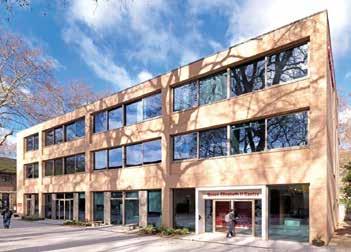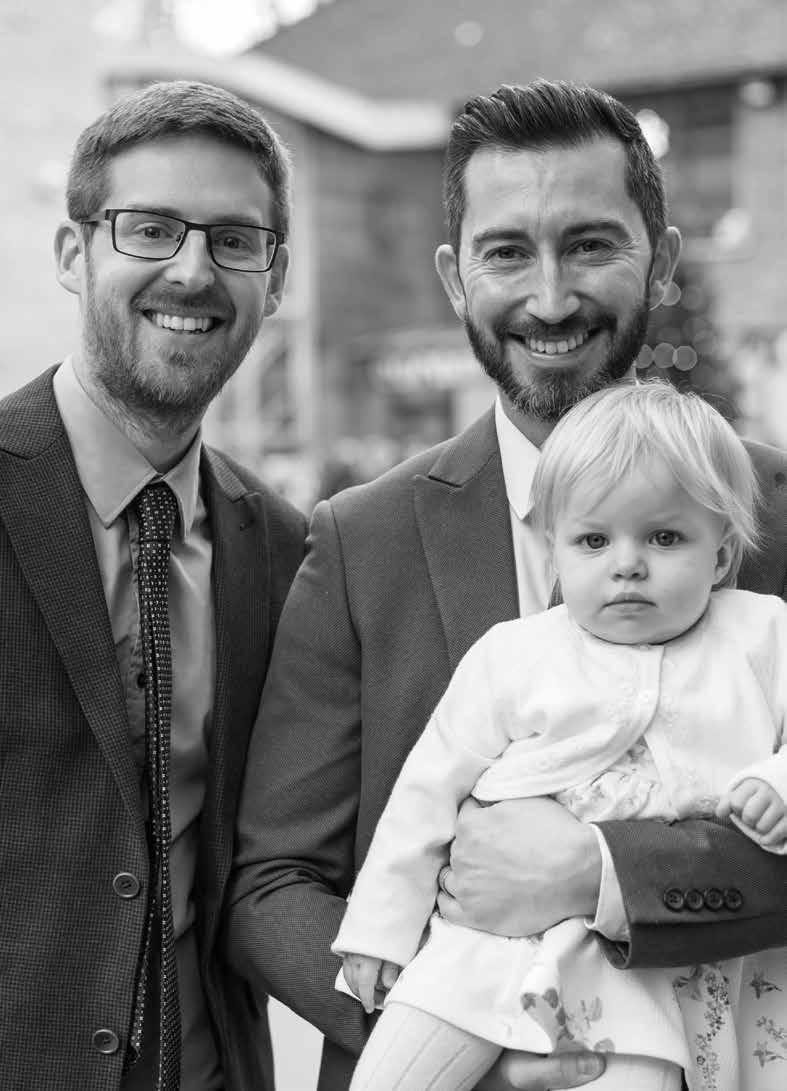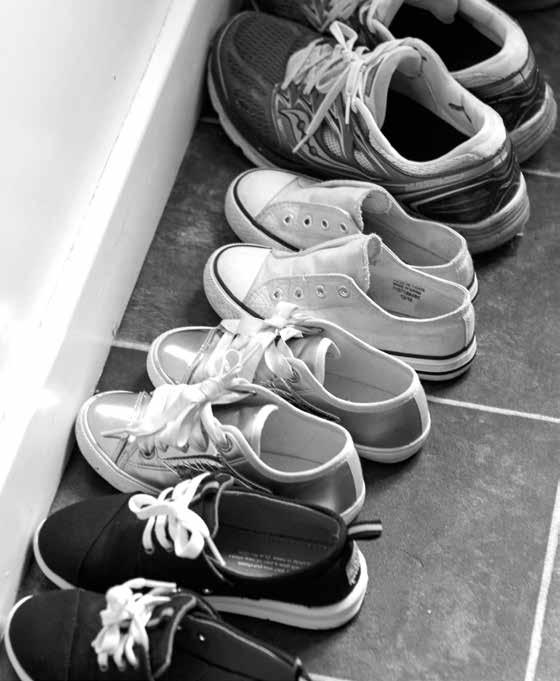of


“We planned to bring my father, who was adopted through Coram, here on his birthday. But devastatingly he died due to Covid in April. Yesterday I was married in Marylebone, I just want to lay my bouquet in his memory.”



“We planned to bring my father, who was adopted through Coram, here on his birthday. But devastatingly he died due to Covid in April. Yesterday I was married in Marylebone, I just want to lay my bouquet in his memory.”
It is the ongoing reality in our society that some children in care are unable to return home or be cared for within their wider family network.
Many of these young children will have a plan of adoption and need adoptive parents who can love and nurture them for life.
It is to this task that Coram Adoption has always been dedicated – putting children first and foremost to ensure that they grow up safe in loving families by supporting the diverse and remarkable people who make a lifetime commitment by adopting a child.
In doing so, Coram has built on three centuries of experience as the first and longest continuing children’s charity which, as The Foundling Hospital, was the birthplace of children’s social care, developing regulated foster care and providing support from infancy to independence for children at risk. For their mothers who faced destitution and stigma, this gave hope of a future for their baby.
Over five decades, Coram has delivered outstanding services as a voluntary adoption agency to support children who, despite changes in social attitude and support, still need that love and long term, legal security which only adoption can provide. Coram has constantly adapted to the new challenges of the modern era and pioneered progressive practice to ensure that the most vulnerable children find loving families in their timescale and that their new families are supported to meet their needs, including via appropriate contact with members of their birth families.
Coram “is leading early permanence and adoption work in all its aspects.”

Ofsted 2022
Coram has pursued the shared aim of supporting the most vulnerable children to leave care by working with colleagues across the sector through national programmes, forming progressive partnerships and now leading one of the regional adoption agencies with local authority partners.
We support the UK’s dedicated community of adoption, fostering and kinship care professionals and are committed to advancing research insight and practice to improve outcomes for children.
Every day – inspired by and working with adopted children and their parents – Coram’s mission is achieved thanks to the skills and dedication of professional social workers, wider multi-disciplinary colleagues, partners, regulators, policy makers and supporters as well as all those in the legal system who have the duty to ensure that the welfare of each child is paramount in the decisions made for them.
As we mark a historic milestone for Coram Adoption, we thank them all for their service and support and celebrate the adoptive families who have so generously shared their stories and the lifetime of difference they and all others make for our children and for our society.
Dr Carol Homden CBE, Chief Executive OfficerHer Majesty The Queen first visited Coram, then the Foundling Hospital, as a child in 1936 and returned throughout her life, meeting adopters and adopted children and young people. In 2018, she was welcomed by Isaac, with his drawing of Buckingham Palace reflecting on the importance of forever family for adopted children.


Coram has a long history of offering care to children who cannot grow up within their birth families. Thomas Coram established The Foundling Hospital – the first and longest continuing children’s charity in 1739 – to support babies who would otherwise be abandoned, and most likely die, on the streets of London. These children’s mothers were mostly unmarried and Coram hoped to enable them to continue their lives without the stigma of illegitimacy. The babies were placed with foster mothers until the age of 4 or 5 and then moved to the Foundling Hospital. Still based in Brunswick Square in central London, the site of the original Hospital, Coram is the birthplace of children’s social care.
From the end of the 18th Century Coram provided support to former pupils who were in need. Since 1976 when the law changed to allow adopted adults access to their birth records, Coram has provided a similar service to former pupils of the Foundling Hospital. Prior to that Coram was bound by the anonymity promised to the children’s birth mothers. The former pupils were
supported into apprenticeships, the services or other work and remained under the auspices of the Hospital until the age of 21. The children remained at school for 52 weeks a year and did not return to their foster families again. The impact of this – in an era of total lack of public services and centuries before the advent of modern psychology – was not fully understood until much later.
However, children benefitted from education (in an era where many were illiterate), stability (without multiple moves), entry into employment with support until they were 21, and the community of their peers, all of whom were “in care.” 2022 marks the final year of the Old Coram Association after 75 years of service.
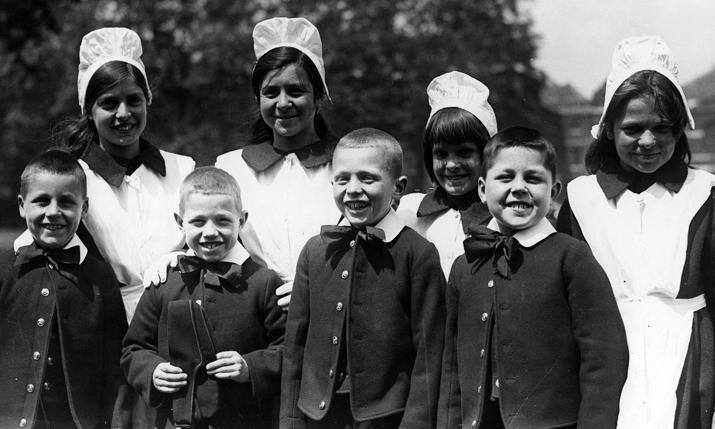
The development of child psychiatry – especially the work of John Bowlby and James and Joyce Robertson – brought a better understanding of the developmental needs of children and the detrimental impact of disrupting children’s attachments. The Curtis Report 1946 (Report of the Care of Children Committee) provided a comprehensive review of the care offered at the time to children “deprived of a normal home life with their own parents.” In particular it recommended the closure of
large residential institutions and a greater provision of substitute family care or smaller residential homes. At the same time a group of foster carers wrote to the Governors of the Hospital and the Home Office highlighting their concern about the practice of removing young children from the security of the only family they had known. In response, the Governors of The Foundling Hospital began to work towards the reform, and eventual closure, of their residential school, by now situated in Berkhamsted (now Ashlyns secondary school). The
foster families who had regularly provided early years care for children before their admission to the school were encouraged to take children home during school holidays. In the 1950s the role of foster families was extended further so that children were no longer removed into the school at five years, but placed full time in their foster families until they were of an age to leave care. Those children who were already at the school, and who did not have foster families willing to assume their full time care were gradually found new foster families.
The Children Act 1948, ushered in the recommendations of The Curtis Report For Children in Public Care and the Thomas Coram Foundation for Children (as Coram was then known) began to develop new approaches to childcare and to evolve into the child-centred organisation we see today.
When admissions to The Foundling Hospital ended in 1954, the retitled organisation began to recruit and support foster families, permanently shifting its focus to the provision of long-term family care and build on its well established work with mother and baby and community support.
Adoption was legalised in 1926 and the peak in the number of adoptions in England and Wales was in 1968. Generally this involved the babies of single women who had no alternative as there was no public provision to support them and they often felt pressured by social stigma and family or by adoption agencies, most of which were established with religious affiliations.
In this context, Coram offered a welcome alternative to mothers who did not want to give
their babies up for adoption and who hoped that they might one day resume their care. Young women who placed their baby in the care of the Thomas Coram Foundation in the 1960s retained their legal rights and responsibilities, many of them keeping in touch for news of their baby or even visiting foster families. In some cases mothers were later able to resume care of their child when their circumstances changed. On occasion the babies were later adopted by our foster families but only with the birth mother’s consent if she agreed that this was in the best interests of her child.
Importantly, infants who were subsequently adopted by their foster parents were spared disruptions and were afforded a continuity of care in a family in which they were already settled. This pattern was one reflected in some of the later work in Coram’s adoption service, particularly Concurrent Planning and Early Permanence (see page 18).
The Children Act 1969 clarified that the overall responsibility for children growing up outside their birth families should fall to local authorities and The Local Authority Social Services Act 1970 saw the creation of new social services departments. This led to local authorities becoming responsible for residential and foster care for children who were separated from their families. This meant that the balance of need shifted and in 1972 Coram became a registered adoption agency, continuing to provide A Lifetime of Support for children in care.
“My mother was a waitress in an ABC Café. Amongst her regular customers was an older man. He was 33, she was 19 and they became more than just friendly. After about a year he said. ’I’m going to go back to my wife and children’ – about which she knew nothing. She was devastated and also discovered that month that she was pregnant. At which point she was sworn to secrecy and sent off to live with an aunt. By the time I was born in the Mile End Hospital in East London my mother had applied to the Foundling Hospital to admit me. I was accepted into the hospital’s care and placed with a foster mother. At the age of 4 I was moved to live at the Foundling Hospital in Berkhamstead
I remember my first day really clearly. Being put in a line of girls and having our hair cut to the same pudding basin shape. Then being thrown into the bath and all us of putting on the same prickly dresses. The school was very strict and regimented and we were called by our surname so I was Prynne. Or “A5” after the dormitory I was in.
When I was six or seven I developed a serious earache and I was put into the sickbay with a girl called Evelyn. She was there because she had very bad asthma. We were being guinea pigs for penicillin which was new at that time. So we spent a blissful six weeks in the summer of 1942 chatting, swimming playing and eating. No rules, no haircuts none of the normal routine. Evelyn was a lifelong friend. Sadly, she died
Eleanor Allen was a pupil at the Foundling Hospital in the years surrounding the Second World War. She subsequently enjoyed a successful career as a music teacher and journalist and is now a great grandmother. She shares her memories here.
this year but to her dying day that’s all we ever talked about. Other people, our contemporaries, were so envious.
It was ages before I discovered that I was actually called Eleanor Prynne. Which sounded a bit pompous to me at first but I grew to like it.
During my time at the Hospital we had a very progressive music master who taught me to play the oboe and my talent for music led to a Scholarship at Malvern College. I remember Miss Brooks, the headmistress, insisting that we create a history for me that was “acceptable.” She came up with this story that my parents had been killed in a car crash and I had to learn this parrot fashion. I was completely out of my element at the school, which was full of debutantes going off to May Balls and the like. Fortunately, I had a lot of music teaching and that eventually lead to me going to the Royal Academy of music. I didn’t think I’d get in but I did.
I loved the Royal Academy. I had a lovely professor of woodwind a lady known as Margaret Elliott who later became Margaret Asher. At one point, I lived with the Asher family. This was when the daughter Jane was going out with Paul McCartney and he used to babysit for me. My best friend at

Malvern was a girl called Jane Allen and she had a brother called John who used to come and take us out in his car. When he came back from national service in 1956 he proposed to me and I said ‘yes’. The marriage lasted 58 years long and we had four children who grew up to be very successful people. I had a good career in teaching and music and at the age of 60 I took a degree in English. I then worked in journalism for six years and became a volunteer at the Foundling Museum. It was John who encouraged me in my sixties to find out more about my past. I worked with Val Molloy, a Senior Social Worker at Coram, who helped us look through my records.
Eventually I met my three half siblings. One of my sisters is only a year and a half younger than me. My mother had got pregnant again and went on to marry the father of my half-sisters. My feeling has always been if you had a baby in your arms and you had to part with it, you’d want another one. So I understand that. I was really happy for her and they said she was a brilliant mum. Sadly I never met her as she died in 1994 and I only began looking for her in the early 2000s.
Thankfully, a lot of the gaps in my past have been filled. Many of them thanks to my Foundling Hospital contemporaries who I still meet from time to time. They know bits that I don’t remember or things that I never knew. Which helps make sense of it all.”

Jeanne Kaniuk became Head of Coram Adoption and Permanent Families Service in 1980 and remained until her retirement in 2018. Active in research, she led the way in thinking about adoption as suitable for a range of children with more complicated backgrounds or special needs. Jeanne promoted professional development and pioneering practice, including specialist training for adopters and multi-disciplinary support which is the hallmark of Coram’s service today. She was awarded an OBE in 2010, a 2014 Social Worker of The Year Awards and was recognised for Lifetime Achievement in the 2016 National Adoption Week Awards.

From its registration as an adoption agency in 1972, Coram was – as it has always been – dedicated to finding permanent homes for children in the greatest need.
In the early years of Coram Adoption, only a very small proportion of children in care were considered as potentially available for adoption. These children were frequently placed in children’s homes.
The publication of Jane Rowe’s book Children Who Wait (1973) had demonstrated that children in care frequently remained there throughout their childhood and often lost contact with their families – something that was not widely appreciated at the time. This research led to a major shift in policy and the government introduced legislation (Children Act 1975, Commencement Orders 1987) which enabled courts to make Freeing Orders – which dispensed with parental consent to adoption if certain conditions were met – essentially that the ‘parents were withholding their consent unreasonably’.
Defining what was ‘unreasonable’ was not straightforward, but this legislation remained in force until the Adoption and Children Act 2002.
Unlike other adoption agencies at this time, Coram did not focus on babies relinquished for adoption by single mothers. Instead, the service prioritised placing children from local authority care, either older children or babies with additional needs. Potential adopters were regarded as a very special
resource to meet the needs of the children.
Unlike most other adoption agencies Coram sought families for those with disabilities and complex needs and was determined to do more in line with the Adoption Agency Regulations (1976) which aimed to better regulate and professionalise adoption work.
In the 1980s there was little experience of selecting children who were already in public care for adoption, nor of the kinds of support that they and their adoptive families might need. Likewise, there was no experience of planning for permanence for children who could not remain with their families.
This meant that children often spent considerable time in the care system before a decision was made to seek an adoption placement and protracted court proceedings often followed. Local authorities usually referred either babies who had been born with significant disabilities, those relinquished for adoption, or older children who had been in care for several years.
In order to improve the support available to children and families, Coram established a contract with the Tavistock Clinic to refer children for assessment and intervention.
This meant services could be put in place speedily and ensured that children and families received expert, specialist clinical assessment and treatment.
Alongside the link with the Tavistock, Coram commissioned a consultant child and adolescent psychotherapist to provide monthly consultation sessions to support the team and deepen their understanding of the children’s emotional needs.

The Children Act 1989 was an important piece of legislation which established the ‘welfare principle’ – i.e. that the welfare of the child should be the primary consideration in decisions about their care including in legal proceedings and; the Act was implemented in 1991, heralding a rapid development of professional practice, care planning and adoption support.
In the early years of Coram Adoption the majority of children placed by local authorities has complex needs. The children referred by LAs all had complex needs. Some were babies born with disabilities (eg Down’s Syndrome or Spina Bifida). Many of the children referred were older children who had come into care having experienced adversity, trauma or neglect, often over a prolonged period. Often, these children were in sibling groups who had experienced multiple moves between foster homes or local authority care.
Recognising that potential adopters who were considering parenting these children needed support and information as early as possible in the adoption process, Coram’s adoption team began to introduce regular information evenings as a first step for anyone thinking about adopting. These meetings were followed by a more intensive series of preparation groups for those wishing to embark upon the process.
The nature of these groups has evolved over the decades but they continue to provide prospective adopters with a realistic picture of the children needing families and the challenges that may be involved in parenting them.
Recruiting black adoptive parents
Coram was conscious of the importance of finding adoptive parents who could reflect the backgrounds of all those children placed. In order to promote the recruitment of black adopters the team established a relationship with The New Testament of God Assembly Church in East London which was led by Pastor Io Smith, part of the Windrush generation and a dynamic leader committed to providing support for her church community.
Pastor Smith’s book, An Ebony Cross, co-authored with Wendy Green, foreword by Archbishop Robert Runcie, (Marshall Pickering, 1989) outlined her understanding of the discrimination suffered by the black community in the UK, and her mission to address these issues. She was immediately drawn to the idea of ensuring that black children who could not grow up in the families into which they were born should be welcomed into black adoptive families and be supported and welcomed by the community.
Coram placed a significant number of black children with members of the church and they were welcomed and supported by the wider church community and recruiting and supporting adopters from diverse families has remained at the forefront of its concerns.
“Charlene came into our family because Ellen and Tom, grew up in Africa and thought England was boring when we returned!” remembers Annet. “They wrote a complaint letter to social services which somehow found its way to Coram and that’s when the adoption process began.
When she came to us Charlene did not talk or walk and we were told that she never would. Her brother and sister refused to accept this. It was Tom who decided that Charlene should go to nursery and they did play therapy together with the speech therapist. When Tom stole her toy money she began to swear at him and the speech therapist was so excited. Apparently Charlene could say every letter in the alphabet! By the time she was ready for school she was able to walk as well as talk. Plus she was able to go to a mainstream primary school.”
“I think I was trying to keep up with my brother and sister” laughs Charlene. “They were always talking to me and I wanted to join in.” Charlene is now 39 and lives in supported accommodation in South Wales.
“I like dancing, cooking and gardening” says Charlene. “I go to church on Sundays and help with the children there. My sister Ellen lives close to me and I love seeing my little nephew, Jonah.
My brother lives in Holland and I hated not being able to see him during the pandemic. One of my happiest memories is visiting Cameroon which I’ve been to five times. I first went there when my Dad was working in Ebolowa as a doctor and I’ve been back to see friends and to a wedding. From 1997 to 2000 I lived there and went to school. My classes were in English but I also learnt French and Bulu from my classmates. It showed me what was possible despite my disabilities. I’m lucky, I have a happy life.”
“We are lucky to have Charlene” adds Annet. “Everybody in our family has said that she changed all our lives. We love her so much.”
Annet and her husband Martin adopted Charlene in 1986 when she was 3 years of age. At the time, their two older children, Ellen and Tom, were aged 7 and 5. Here, Annet and Charlene share their memories of family life.


“If one adopts a child of a different race one becomes a multi-racial family”Robert
Colin and his wife Ruth are a white British couple who adopted three children of black and mixed race backgrounds. Robert was adopted through Coram in 1981 when he was 9 years old. Here, father and son reflect on how they became a family.
Colin: “If one adopts a child of a different race, then one becomes a multi-racial family. Robert’s adoption hearing was initially cancelled on the day as the judge was ‘busy’ i.e. he had another case cancelled and fancied playing golf – so we were told. Thanks to pressure from Coram – and others – it was reinstated at a different court. The hearing lasted all day and the judge eventually announced that he had no choice but to agree the adoption since everyone was in favour - which he knew from the outset. It could have been over in less than an hour. Robert wasn’t allowed in the room at times and when the judge made his decision I told him he should bring Robert back and tell him. This was clearly a novel idea to the judge, but he did it. Our other two children were under a year old when they were adopted, so cannot recall not being part of the family. Robert chose to be adopted and chose his new identity and we are very proud of him - and his wife and son. Adoption is a two way process. We have a great family and two delightful grand-children. “

Robert: “I was last to join the family aged 9 and leaving the children’s home was highly traumatic. However, I do remember Mum and Dad placated me with a Wimpy burger and fries which seemed to stop the tears and act as a perfect distraction well-played Mum and Dad! At first, I did not want to be adopted and was assured the choice was mine and mine alone. This arrangement suited me at the time but it was a conversation with Dad’s Mum - who I adored - some months later which convinced me to make things official. I remember having to go to court and say to the judge that this is what I wanted, it was rather intimidating being in a courtroom at that age. But I did fully understand what was happening and why I was there. What was very appealing to me though was being given the choice to choose a new name. I was very pleased although it took a few attempts to select a name I felt comfortable with.
I remember at school learning about Robert the Bruce, and was captivated by his story with the spider. That was the main reason for choosing Robert.
I view Mum and Dad, as my parents and don’t dwell on the years before I met them. The only time it does come-up is when I’m asked about my medical history. I have to explain that I am adopted and don’t have those records. In the past it was quite amusing when people would see my white parents with three dark skinned children and watching their faces when they were told we were Mum and Dad’s. My family now includes my lovely wife , my wonderful son, Dad, Mum plus my brother and sister. We also have quite a large extended family including my half-sister who I am in touch with. I’ve had a very creative life so far. Working in the music industry and video gaming has allowed me to travel the world. I’m now a content creator on YouTube with over 86,000 subscribers. Being surrounded by loving people has made me a fair and easy-going person despite a very traumatic background. Adoption was very much the right thing for me. To offer a young person the stability I needed when growingup. However, I very much agree adoption is a two-way-street. I cannot stress that enough.”
“Adoption is a two-waystreet. I cannot stress that enough”
Claire adopted Sarah, then aged 8, in 2000. Mother and daughter share their memories here.
Claire: “In 1999 I was divorced and had my son, Piers, who was then 18 years old. I’d also had an ectopic pregnancy and a miscarriage but always wanted more than one child. Despite the fact that I was a social work manager with children and families, it hadn’t registered that single people could adopt. Eventually it just clicked and I went for it. At first I tried my local authority but they didn’t believe in single people adopting. Then I went to Coram who were lovely. Actually, it was my son who saw Sarah first. He spotted her profile in the magazine, ‘Be My Parent’. She was seven nearly 8 years old then.”
Sarah:”I remember them coming to visit me at the foster carer’s house. My sister was in the home as well. But my sister didn’t want to be adopted. We’d been placed together the year before with another family. But my sister said she didn’t want to be adopted. So it didn’t happen.”
“I really wanted to be adopted. So I was really happy about being part of a forever family. I was sad to leave my sister but it wasn’t traumatic at all.”
Claire: “Sarah eventually came to live with us in the Summer of 2000. I remember it was the school holidays and I drove her past her new school so that she could see it before she started. I also remember one of the first things we did was to go out shopping together. Just the two of us.”
Sarah: “It was the first time I’d really gone shopping just for me! I was really pleased to have my own room too. Mum let me paint it yellow with the moon and stars across the top of it. My life was very different to the way it had been. I’d moved to a totally different area as well. From Berkshire, where my foster home was, to North London. Now I was living in a lovely Edwardian house with two dogs and, eventually, a cat.”
Claire: “Sarah kept asking for a cat from really early on. I said when she felt at home she could help a cat feel at home. Thankfully she settled in very quickly and we did get a little kitten. One of the most surprising things was when Sarah said she’d wanted to convert to Judaism. I never expected Sarah to do anything religious. Yes, we were Jewish, to the extent that we had Friday night, but Sarah was the one who pushed it. She said if I was Jewish then so was she. Sarah went on to do GCSE Jewish studies which I was stunned by. My son didn’t do that! She had her Bat Mitzvah and her sister and older brother both came. Which was lovely.”
Sarah: “We also met my biological mother when I was 15. I really wanted Mum to meet her.”
Claire: “It was lovely. She thanked me for what I’d done and I thanked her for having Sarah. Of course, I was very nervous at the time but I’m really glad we did it.”
Sarah: “I’m still in touch with her today. Nothing that’s happened is her fault and I don’t think it’s fair that she doesn’t get to see how I am and what’s happening in my life. So, she’s met my children. I think for her to be able to see them is really important. She sends them things on their birthdays. Which is very lovely of her because she doesn’t have much money. I’m still in touch with both of my birth siblings too. My brother loves being an uncle and he’s always sending presents for the kids at Christmas and birthdays.”
Claire: “I’m very proud of all Sarah’s achievements. She’s a law graduate with a post grad-qualification and now works as a primary school teacher. She met her husband when they were teaching together and now their oldest, 4-year old, Alfie, has just started in Reception Class at Sarah’s school. You don’t think when you first adopt that it’s something that continues through the generations. I’m a grandmother now just as much as if Sarah was my birth child. With Sarah and her husband, I’ve got two, almost 3, grandsons. With Piers and his wife I’ve got one and another coming next year. It’s been wonderful.”
Sarah: “For us, adoption is just normal. It was another way of becoming a family and is no different to a biological famiy. We annoy each other like any mother and daughter but also support each other unconditionally. I used my own experience to become an independent visitor to a child in care. She was 11 when I met her and is now in her 20s. One thing she has always commented on is that I have normalised her experiences and reminded her that a lot of relationships she has built with people are no different just because she had a different upbringing. When she was mad at foster carers because they wanted to impose a curfew, we spoke about how any parental figure would do that. I have a very strong belief that the way our families are built shouldn’t change our worldview on those relationships and that being adopted isn’t an excuse for things.”

“You don’t think when you first adopt that it’s something that continues through the generations”
The Coram HIV Project was established in 1994 as part of the Coram Adoption service. It was set up in response to the need to find suitable care for children growing up in families affected by HIV. The Headley Trust initially provided funding for one social work post for 3 years and subsequently a further 3 years.
Although the level of transmission of HIV between mother and baby was relatively low in the UK, healthy children living in affected families were at risk because of the protracted illness or death of one or both parents. At that time the parents were
unlikely to live long enough to see their children through to independence.
In the Thames region, the majority of children affected by HIV were East Africans, living in refugee, asylum seeking families. In addition to poor health, these parents and children had often experienced trauma, uncertainty, repeated loss while dealing with immigration, benefits, employment and housing issues. Due to the stigma that was attached to the illness it was difficult for parents to share this information with their relatives or statutory services which also contributed to them not receiving the support they needed.
The HIV project employed two part time social workers with complimentary skills; one of these was Ugandan and had a deep understanding of the complex cultural issues involved and the second was an experienced family placement worker. The Project worked closely with other organisations who were recruiting East African respite carers at that time and reached target communities through African AIDS Action groups, churches and “word of mouth.” At a later stage, after children were placed with carers, links were established with the HIV Paediatric team at Great Ormond Street Hospital.
Initially it was expected that most of the work would involve recruiting carers to offer respite placements leading to prolonged or permanent care as parents’ health worsened. However, when a number of relatives and friends offered to care for children, it became clear that some of the placement work would involve assessments for long- term fostering and kinship carers. Since most of these carers were themselves refugees living with complex issues it was important to ensure that they too received adequate support from their local authority, health and voluntary services.
The guiding principle of the project was to find creative, flexible and culturally appropriate ways of providing care for children. Whether the eventual carer was identified by the parent or by the Project it was essential to agree on the legal framework for the placement and to have financial and other support in place.
Responding to the needs and wishes of families living with HIV, the Project pioneered creative solutions for the care of children affected by HIV and made it possible for parents to retain responsibility and look after their children for as long as possible.
In the course of its work the Project enabled a number of children to be placed with kinship and foster carers. Two of those children were HIV positive and continued to receive support from Coram for years afterwards. This included support with behavioural emotional issues, education, hospital appointments, linking into HIV services and helping the carers to impart difficult information about the children’s background including disclosure about their HIV status.
Since its earliest days Coram Adoption has been at the forefront of the development of innovative new approaches to support the most vulnerable children and families.
Agnes became a single parent following the death of her husband through HIV illness. She had two children Ruby aged 9 and Mary aged 5. Agnes was very concerned about the future care of her daughters as she was experiencing increasingly frequent periods of illness and fatigue. The referral to the Coram HIV Project from Social Services was to find a respite carer who would be willing to consider permanent care of the children if and when the need arose. A foster carer of East African background, who was also open to caring for the children permanently, was identified and Social Services then took on the case. Years later when Ruby was 18 and speaking at a conference she met a Project staff member and let her know that her mother was still alive and doing well, thanks to the antiretroviral medication. Ruby and her sister have fond memories of their respite carer.
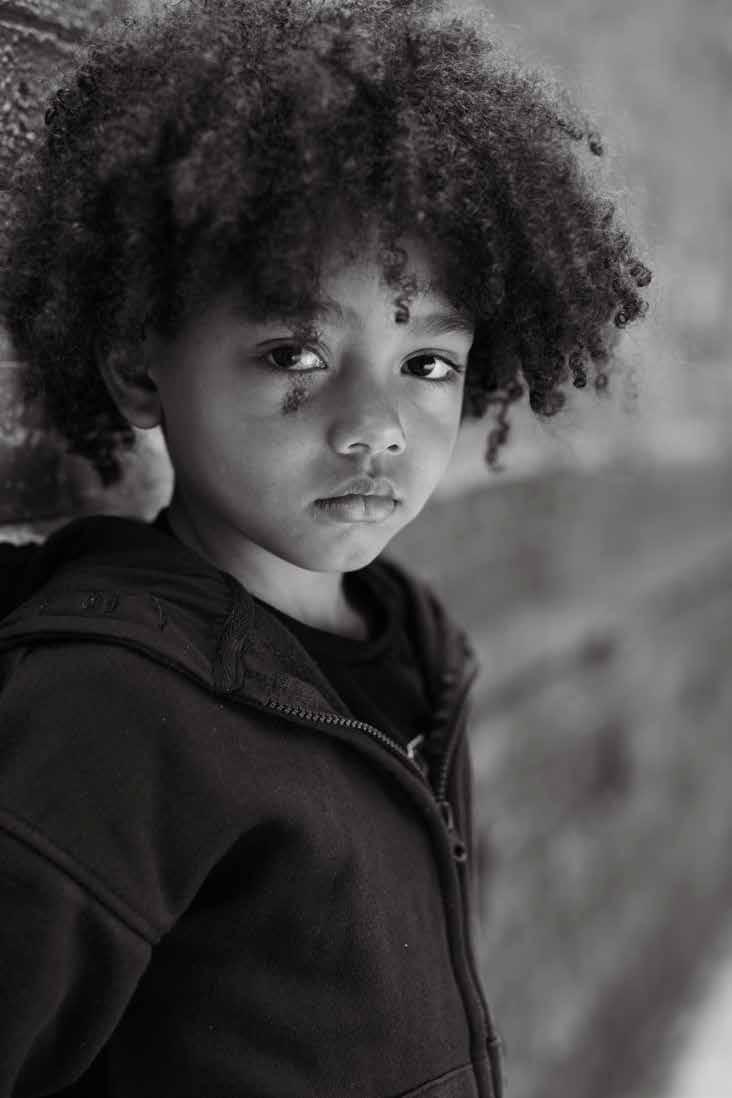
Coram’s Concurrent Planning Project was one of three established in England during the 1990s. It was the only one to continue and evidence long term impact until the government introduced The Children and Families Act 2014 which facilitated making similar placements known as ‘Fostering for Adoption’ placements.
Concurrent Planning (CP) is a family placement option for babies and very young children in care who are likely to need adoption, but who still have a chance of being reunited with their birth family. CP carers are dually approved as both foster parents and adoptive parents and perform the role of foster carers while the courts decide whether or not a child can return to its birth family. The model was introduced based on the US experience and is usually for placements for children under 2, to provide much-needed stability during the vital early years of development.
Managing uncertainty and providing stability Babies placed for concurrent planning are often extremely vulnerable and may come from backgrounds involving substance or alcohol abuse or where there is a history of violence or offences against children. Some are born withdrawing from drugs, have a genetic vulnerability or predisposition to develop some form of mental illness.
Although carers are given as much information as is available about the babies’ backgrounds and health issues, there are always considerable uncertainties and Coram developed a dedicated preparation course, which explains the nature of these placements and the risks involved and prepare for uncertainty.
Supporting Carers and Birth Parents together Supporting the relationship between CP carers and the child’s birth parents is a crucial element of these placements. As part of their assessment carers discuss the kinds of issues that many of the children’s mothers and fathers will have experienced and are encouraged to understand and empathise with birth families. During regular contact sessions carers are able to talk with the child’s parents and share information about the baby’s routine and wellbeing. Over time these relationships have been seen to develop in positive ways, with birth parents feeling included and respected because of the way the handovers were managed. This meant that if the baby did not return to the mother’s care, alongside her feelings of distress, she would feel comforted that her baby would be safe and loved.
Ongoing contact arrangements were put in place as appropriate, placing the baby’s welfare and need for security at the centre of the process. Carers who were also potential adopters took on the risk of the baby returning to his/her birth family if the court decided that was the best outcome for the child.
Rebecca is a single parent of two adopted sons aged 4 and 1 years. She adopted her oldest son through a Coram early permanence placement.

“I always knew I wanted to have a family through adoption and so I built up child care experience from my teenage years onwards. I volunteered with church children’s clubs, YMCA groups and volunteered in schools.
Initially I began fostering and planned to become a long term foster carer of siblings. But it turned out I only had short term placements. When I was more financially secure I tried to adopt through the same local authority but was prevented from doing so. I’d heard about Coram, especially their work in early permanence and I followed them on Twitter. When I realised that I wouldn’t be able to adopt through the local authority, I phoned Coram. I was really impressed that Coram took time to consider my situation instead of dismissing my enquiry as other social workers had done.
I really wanted to adopt siblings. But, to maximise my opportunities to be approved I put myself forward for both mainstream and early permanency. I adopted my eldest son through Coram and he came home as an early permanency placement when he was just over 3 months old. The adoption order was granted 9 months later.
I was fortunate to be able to meet birth family regularly prior to adoption. I took my son to contact sessions a couple of times a week while I was fostering him. This was a wonderful opportunity to find out more about them and for them to find out about me in a more informal way. My son began sleeping through the night quite soon after he arrived and appeared to be a settled and contented child. However, during the first lockdown his attachment to me greatly increased.
The lockdown provided a unique opportunity, free from other distractions for the two of us to just to spend time together. I realised the extent of the impact when the lockdown ended. He was being looked after by another family member and, when he caught sight of me, he smiled with happy recognition for the first time. He is now 4 years old and I love spending time with him. I have just adopted another child through early permanency and would love to do it again when the boys are a bit older.”
“I was really impressed that Coram took time to consider my situation instead of dismissing my enquiry as other social workers had done.”
Coram continues to lead the way in the development of best practice and the sharing of research on the impact of contact to ensure the best possible outcomes for children leaving care. This has included influential studies of children and families in early permanence placements and research into attachments between older children and their adopters.
Jenny Kenrick’s Concurrent Planning study on the impact of contact In 2009 Jenny Kenrick (Honorary Child and Adolescent Psychotherapist, Tavistock Clinic) published a retrospective study* of 26 families who had cared for and later adopted a baby via the Coram Concurrent Planning Project. The adoptive mothers were interviewed about the impact of contact on the babies with their birth parent/s during care proceedings.
At that time contact between mothers and babies during care proceedings were generally set at a high level, influenced by the judgement of Mr Justice Munby in Re M (2003), who viewed high levels of contact as necessary for the mothers to maintain a relationship with their babies. This judgement was the subject of much debate and was later influenced by Kenrick’s research.
Kenrick’s research demonstrated that high levels of contact (commonly 3-5 times per week) affected the babies’ capacity to establish routines and indeed often actively disrupted their existing routines. The babies were often distressed during contact, and needed a considerable period to recover from contact.
Another finding was that babies around the age of 5 – 8 months were considerably more distressed by contact sessions
than younger babies. This related to the developmental stage when babies become more attached to their main caregiver and find separation from her/him more difficult, even if a baby had settled into a pattern of contact at an earlier stage, when s/he reached this developmental stage, they often displayed more distress.
Alongside describing he distress suffered by babies during contact, the adoptive mothers also gave positive feedback about the value of contact as a means of developing a greater understanding of the birth parents’ difficulties and qualities.
This would help them to talk to their child in future years with understanding and empathy. It also made the management of post adoption contact more meaningful.
This research was widely disseminated to professionals and had an impact on the levels of contact set by the courts. It also helped to reinforce understanding of the importance of managing and supporting contact sessions and building relationships between CP carers and birth families.
“Over the last 20 years of being a family judge, one of the most inspiring initiatives I have seen develop has been Early Permanence Placements (EP). Everyone in the case has the reassurance of knowing that the baby will have the chance to build a relationship with the birth parents through contact, but will at the same time develop a strong attachment to the EP carers, an attachment which can be transferred to the birth parents, or will continue with the EP carers. Particularly at a time when care proceedings are taking longer, I know how important this is for that child’s whole life’’.
Her Honour Judge Lynn Roberts, Designated Family Judge for Central Family Court.
Kenrick, J, ‘Concurrent Planning: a retrospective study of the continuities and discontinuities of care, and their impact on the development of infants and young children placed for adoption by the Coram Concurrent Planning Project’, Adoption and Fostering, 33:4, pp 5-18, 2009.
Coram Outcome Study for children placed in CP families (2000 – 2011)
Coram studied the outcomes and backgrounds of the first 57 children placed by the Concurrent Planning project in 46 families. After 10 years, 54 of the children placed through Concurrent Planning had been adopted by their carers while 3 children had returned to birth families. The research showed that during their lives to date, 68% had no or moderate support needs and 32% had moderate to high needs. Parents recognized that children were likely to move between these categories as they grew up. Five children were diagnosed as autistic with very specific support needs.
Most children had some contact, usually with their mothers, but in some cases there was separate or combined contact with birth fathers or other members of the birth family. 7 children had direct contact with a member/s of their birth family, letterbox contact for 15 children, 3 had no contact.
From our study 68% were free of major difficulty compared to 53% in Selwyn et al study 2006, or the Rushton and Dance study, 2006.
In 2000 Coram established a research project together with the Anna Freud Centre and Great Ormond Street Hospital to explore how attachments developed in children who had experienced neglect and trauma in their birth families and were then placed for adoption. The project was funded by the Sainsbury’s Family Trusts.
Prospective adopters were assessed before their children were placed with them to establish their own attachment status (secure or insecure). The children who were included in the study were aged between 4-8 years at placement and came from backgrounds of severe adversity. There was also a control sample of
Follow up study – 2017 – 2018 by Anna Ponomarenko, Jeanne Kaniuk and Jeff Mesie
Twelve families with Early Permanence placements were followed up in 2017 – 2018. At the time of this research the children were aged between 7 and 12 years. At least half of the children had required treatment for withdrawal of drugs at birth and had been in special neonatal care. Two thirds of the children exhibited learning difficulties ranging from minor to moderate to severe at the time of the research. 3 children (30%) had support needs. None of the families who participated in the 2017/18 study had been identified as having moderate to severe support needs in the 2011 study.
Almost all the parents felt that schools were not doing enough to support adopted children and their families. Teachers often seemed unaware of issues that might be sensitive for an adopted child.
Most parents were positive about having had the opportunity to get to know their child’s birth family prior to placements. However ongoing contact was more complex and tended to ebb and flow over the years. In general
children placed in infancy.
There was clear evidence that in the first months of placement the children did not anticipate having their needs met by their new carers. Pleasingly the picture shifted in significant ways when the assessments were repeated after one year and then two years. There was clear evidence of many of the children beginning to expect parental care and attention. This change in attachment status is generally linked with better emotional, social and cognitive development.
This research was followed up when the children were adolescents and demonstrated that those children whose adopters had secure attachments were more settled in school and enjoyed better relationships than
Selwyn et al study 2006, or the Rushton and Dance study, 2006.
the adopters felt equipped to answer their children’s queries about their birth families because of the contact they had had with them prior to placement.
Most families had accessed professional support at some stage and said that they would contact Coram if they needed future support. Families reported long waiting lists for support from CAHMS or local authorities and expressed a desire to network with other adopters. In response, Coram established monthly Play and Stay groups for the parents with pre-school children which were well attended and valued by the adopters.
those whose adopters had demonstrated insecure attachments in the initial assessment. The research is currently following up the adoptees who are now in their late 20s.
This research has helped inform adoption practice within the UK and beyond. There is a better understanding of the dynamics of attachment and what adoptive parents can bring to support their children’s development and recovery from earlier adversity. It has also helped in the development of therapeutic interventions to support adoptive parents and their children, including the Incredible Years Parenting Skills Groups (see p31) adapted for adopters described elsewhere in this report.
Talia and Dan both 33 adopted their son, Billy, in 2022.
Talia: “I knew I always wanted children but I didn’t feel any need to have biological children. Even from a young age, I’d always thought that I would adopt. My point of view is ‘why wouldn’t you do it?’ When Dan and I got together he was very relaxed about it and said ‘okay’. So, when the time was right, it felt like the natural thing to do.”
Dan: “The first thing we had to decide was whether we wanted to go to a local authority or a voluntary adoption agency. Initially we did go to one local authority. But very quickly we understood that the support that child may need was going to be a crucial part of our choice.”
Talia: “It was very clear to us that Coram was the best option. Compared to local authorities around us and other voluntary adoption agencies it was obvious that Coram could provide amazing support. Also, we knew quite early on that we would like to foster to adopt. Early Permanency was something
we were considering and not every agency does that. Initially we’d wondered whether fostering to adopt was the right choice for us. What if the child returned to his birth family? How would we manage that risk? But, as we began to research the process, we realised that although it was a risk to us, the uncertainties for the child far outweighed anything we might experience. As adults, we have the resilience to take and manage that risk.
The more we thought about it the clearer we were that early permanence was the best option for the child. We wanted to remove the burden of risk from the child and give that child as much continuity and security as possible.”
Dan: “Our adoption experience coincided with the peak of the Covid-19 pandemic. We were approved in August 2020 and after a couple of unsuccessful links we eventually found out about Billy in April 2021. At first we were cautious. But, once we’d seen his picture we were very excited and, six weeks later he moved in! The adoption order was granted in February 2022.”

Talia: “Our introductions were relatively short. We met him on Monday and he moved in on Thursday. He was a very relaxed baby and he’s settled in amazingly well. We have nothing to compare it to of course but everyone has said so. He was a good sleeper he took his feeds. He was a really happy baby.”
Dan: “Probably a big part of this is down to the foster family that he was with before he came to us. They were absolutely incredible with him. We were so lucky. He’s funny, he laughs, he likes people a lot. To the point at which he ignores us and goes off and does things. We couldn’t wish for more.”
Talia: “Who knows what the future holds. But I think it will involve another child. We just need to decide whether early permanence would be an option now that we have Billy. Because it isn’t just about us any longer. Anything that happens will happen to the whole family. But we’ll definitely adopt again.”
“We wanted to remove the burden of risk from the child and give that child as much continuity and security as possible”Talia, Dan and Billy
Coram’s child-centred approach and emphasis on avoiding delay for children awaiting placements has helped shape and define best practice within our sector.
The success of Coram’s Concurrent Planning project prompted the government to introduce Fostering for Adoption (FfA) under the Children and Families Act 2014. Under this legislation local authorities were able to place a child who was in care proceedings with approved adopters if they considered that adoption was one possible outcome of the proceedings. In order to meet the requirement that the prospective adopters would act as foster carers during proceedings, the Local Authority was empowered to temporarily approve adopters as foster carers in respect of an identified child. The main difference between FfA placements and CP placements was that the FfA placements did not require the carers/prospective adopters to go through a process of approval as foster carers. Coram’s view was that the aim of both approaches was the same – to ensure that children in care proceedings could join what might be their permanent family as soon as possible, but without undermining the birth parent/s and extended families’ right to be considered as the best choice for the child at the end of proceedings. In order to avoid confusion, Coram adopted the term Early Permanence to include both models. Early Permanence (EP) is now widely used to describe these
placements by adoption agencies and local authorities and many of them have introduced systems similar to Coram’s to prepare prospective adopters. Coram has trained adoption social workers from a range of adoption agencies to use the Coram preparation Early Permanence programme and manual.
Coram’s Early Permanence Network
With the new legal framework provided by Fostering for Adoption, local authorities had a duty to consider such placements for children in care proceedings for whom they were responsible. Coram received a number of requests for consultation and training as we were then the only dedicated concurrent planning scheme in the UK. In order to meet the high level of requests for training and consultation on the implementation of FfA schemes, Coram established the Early Permanence Network
The Coram Early Permanence Network was a membership subscription scheme which offered three conferences each year plus access to additional training and consultation which could be commissioned. Members had the benefit of peer support as well as access to leaders in the field.
The scheme was open to Voluntary Adoption Agencies, local authorities and later
Regional Adoption Agencies. Training encompassed topics including: recruitment and preparation of EP carers, managing contact, supporting parents whose children are in EP placements, rehabilitation of children to birth family, health issues affecting babies in placements, placing older children. Some agencies have remained members since the Network launched while others have enrolled only for specific programmes.
Since the Covid pandemic all conferences have been offered virtually, which has made attendance for members across the country easier. From 2015 to 2022 60 Voluntary Adoption Agencies and local authorities have been members of the Network.
More information: earlypermanence.org.uk
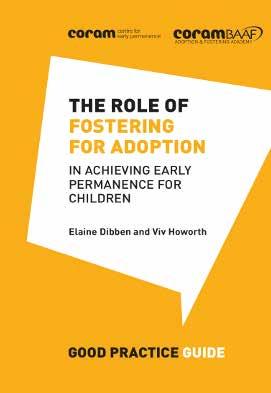

Coram’s approach to adoption has always been child centred and this focus has informed the inclusive approach to applications from prospective adopters.
In 2005 the Adoption and Children Act 2002 was implemented, giving LGBT couples the same rights as heterosexual couples to adopt children. However many agencies including Coram had placed children with LGBT couples. However, although LGBT couples were assessed and approved together, when it came to the legal process, one of the couple would make the application to the court as a single adopter. Subsequently the other partner would apply to become a legal guardian of the child and the couple would share parenting responsibilities.
The 2002 Act made it possible for LGBT couples approved to adopt to make a joint application to the courts.
Coram’s approach to adoption has always been child-centred and this focus has informed our inclusive approach to applications from prospective
adopters. In the 1980s Coram received an application from a heterosexual couple who were already long-term foster carers for a 6 year old girl who had cerebral palsy and limited mobility. * They both worked in education and were aware that a number of children with disabilities were in the care system with little or no hope of adoption. Given their experience – both professional and within their family as foster carers –their application was readily accepted and they were assessed as prospective adopters.
In the course of their assessment, they disclosed that the prospective adoptive mother was a trans-woman. The transwoman applicant explained that since early childhood she had felt like a girl, not a boy, and had sought medical advice as a young woman. After very thorough discussions and assessments, she was offered treatment to transition, and had lived as a woman for some 15 years.
She had been in a stable relationship with her partner for a decade.
It was decided to complete the assessment given the couple’s positive references and their considerable experience of working with children with complex needs. The assessing social worker completed their assessment and made a positive recommendation regarding their ability to care for an older disabled child. At this time, with the understanding of transgender issues still very limited and adoption by same sex couples yet to be legalized, it was decided that it would be more appropriate to approve the couple as long-term foster carers rather than as adopters. Both foster children remained with the couple into adulthood, and were fully accepted as members of their family.
Coram continues to welcome prospective adopters regardless of their sexuality, gender, ethnicity or relationship status.
“
Maire and her partner Juanita adopted brothers Jack and Josh (then aged 6 and 5) in 2006. She shares her family’s adoption story.

Adoption was always going to be an option for us because we knew there were so many children who needed families. When it came to thinking about the type of child – or children – we wanted to adopt, we were pretty open. But we were interested in taking children with additional needs and we were also slightly drawn to older children.
Things have changed so much since the early 2000s but, as a same sex couple, we felt quite a responsibility in those days. Although, our family and friends were very encouraging and Coram had such a positive reaction to us as a couple. Plus, when we went to the adoption open day there were lots of very different people there, which was reassuring.
At first we did have some reservations about not giving the boys a mother and father after they’d already been separated from their birth parents. But I don’t think we did disadvantage them. They have a lot of male role models and really enjoy spending time with both sets of grandparents. Josh in particular finds it quite hard when we ask him “what’s it like having two mums?” he says “I don’t know what you mean .” When he was very small people would say “why do you call them both mum?” Which would confuse him and he’d say “because I know who I’m talking about.”
We were very keen to meet with the boys’ birth parents and I’m so pleased we were able to do that. It was an opportunity to ask each other questions and we talked about what they wanted for the boys. Their mother wasn’t able to write to us and she didn’t collect any of our letters. So, the fact that she came to this meeting felt really significant and we still have photographs of us all together. It’s so important for adopted children to have the opportunity to know
“We still talk about the moment our social worker first showed us the photograph of the boys. At that point we didn’t need to know anything more about them. You could tell such a lot about their personalities... They were cheeky fun boys. They still are!”
who they’ve always been. Then they can take the bits of their history that matter to them.
Family life has been tough at times and both our boys have their own challenges. Jack has additional support needs and although he loved primary school, he found secondary school difficult. One of the key things that we’ve learnt is the importance of longterm support. That’s sometimes difficult to access when you’re apparently comfortable with a nice house and good family support networks. Also, when he was younger, Jack would refuse support – which is a very different thing to not needing it. So you’ve really got to be an advocate for your children.
The boys are doing well now. Both of them play sports regularly and are still very close to each other. Josh lives at home and is working and Jack’s now in a supported placement which he loves. The bottom line is, it was never not going to work for us. We always knew that. It’s been absolutely fantastic and it still is. Are we glad we did it? Absolutely!”

“We fell in love with the whole foster family they were brilliant with Leila and with us.”David, Marwan and Leila
David and Marwan adopted their daughter, Leila, in 2022. Here they reflect on the experience and their first year as a family.
David: “We did quite a lot of reading around child development and the importance of the early years and decided that early permanence would be right for us. We really wanted to influence and support a child from as early as possible in its life. We found Coram very quickly. We did some Internet research and discovered that there was an open evening quite close to our house. We were really impressed with the staff and really liked them and didn’t look elsewhere after that open evening.
Marwan: The minute that we went to the open day I heard the figure. I think it was 75,000 children in need of a home. It’s insane we’re in the UK, a highly developed country and this is the case. We really wanted to give a child a better future. There was no doubt in that. You hear from other Adopters that they’ve tried four or five agencies but for us Coram felt really natural and right straight away.
David: When we got into the process our criteria was to have a child aged under three. But we didn’t think beyond that. Leila was given up for adoption at birth and we first heard about her in August 2021. From the little we’ve learned about the birth mother and the decision-making that happened, we know that she was a young woman ill equipped to have a child. She wanted to give her baby a better life and that’s what she did. Because we’ve never had any contact with birth family we’re going to have to work a lot harder when it comes to life story work. We’ve been really proactive in interrogating her social work team because they had a very initial meeting with Leila’s birth mother. When we come to have those conversations with her we want the information that we have to be truthful, clear and not exaggerated. That’s so important. We’re very much of the mindset : let’s not spend the first five years worrying about whether she’s talking or developing on schedule. Let’s just roll with the punches. Not just constantly refer back to the fact that she’s been a child in care. Actually she’s doing great, given she was two months premature there’s no sign of any abnormalities or delay in anything.
Marwan: In all fairness it’s been a lot easier than we thought it would be. In the early stages you tend to think of scenarios that might be really challenging. I always thought I might be constantly thinking she’s got a runny nose - has that got something to do with her past or her history? Actually I haven’t thought about that at all. I think you’re either too tired or too busy to overthink things! You’ve just got to keep going with the practical side of raising a child. Plus we fell in love with the whole foster family they were brilliant with Leila and with us. They taught us so much. I constantly hear the foster mother’s voice in my head telling me to do things remind me of things we learned in those early days.
David: They were a really lovely family and they got her into a brilliant routine. There was a level of her being unsettled, obviously, she’d moved primary carers. Apart from that she was eating and sleeping well and doing everything you would expect from an eight month baby. Because of the attachment with the foster family she’s really picked it up with us too. In all the classes and groups that we’ve been too, no one has picked up the fact that she’s an adopted child. She’s moved into her own room now and she loves it.”
“We really wanted to give a child a better future. There was no doubt in that. You hear from other adopters that they’ve tried four or five agencies but for us Coram felt really natural and right straight away.”
David Sparks and his wife Barbara are a white British couple who have two birth children. In the 1980s they adopted two girls, Kulwinder and Nina, who are of Indian heritage. David reflects on what adoption has meant to his family.
“We originally talked to Coram about the kind of child we wanted to adopt: no medical problems, maybe a baby boy or girl who was young and white.
What they came up with was a two-year-old Indian girl with major burn scars who was in hospital at the time. Which was about as far from what we’d been talking about as you could conceivably get. Obviously we had reservations but we knew Kulwinder really needed a loving home. We talked to a doctor friend of ours who said “don’t worry.” So we didn’t and went ahead. Of course it wasn’t plain sailing because the medical profession in those days wasn’t as advanced as it is now. Practically speaking the most useful support that we got was from the medical social worker at University College Hospital and the people at Coram. When it came to adopting a second time, it made sense to come to Coram again. Because we already had one daughter of Indian ethnicity when Nina popped up it seemed the natural thing to do. Both our girls have had challenges but I think we all agree we got there in the end. The most amusing part of the whole process was when we went to the family court in Slough and the judge said ‘do you realise how old you’re going to be when your daughters are grown up!’.”
This is an extract from “Why Adoption? Experiences to Share for Teenagers and Their Parents” by Kulwinder Sparks originally published in 1995.

When she was 17 years old Kulwinder wrote about her own adoption experience to help other teenage adoptees and their families better understand each other.
“When I was nearly two there was a house fire at my parents’ home. Both of my parents died and I was in hospital for five months being treated for serious burns. I went to live with my adoptive parents when I left hospital. I was adopted two years later.
My mum started talking to me about my past very soon after I came to live with them, because it was so obvious that I was not their birth child as I am Asian and they are white. Mum had to explain to me that I had another mummy and daddy who had died, and that it wasn’t because I had been really awful but it was just something that happened. She explained why her skin colour was different from mine, and of course when she told me that she wasn’t my ‘real’ mummy, she had to explain what happened to my ‘old mummy’, and why she died.
My mum made me a book with photos in it, of me in hospital, when I visited them, when I came to live with them, then she wrote short captions underneath. We wrote the book together over a long period. My mum helped me come to terms with the fact that it wasn’t my fault that my parents had died, and also helped me come to terms with having scars. When I started school my mum had to talk to me quite a lot about my scars and skin colour, because at break times we used to play games where you held hands in a circle, and to start with some of the girls would not hold my hands because they didn’t like the look of them. It helped me come to terms with being scarred when my mum talked to me about the fire and how I spent five or six months in hospital being treated for burns. We think this is why I am not at all keen about going to the doctors or the hospital, even though the fire was about sixteen years ago.
All through my life with my adoptive family we have talked about any problems that I found hard to face. It is hard to talk about these things, but if the problems are faced and talked about early, then straight away the healing process can begin. I found that I could look at things which happened to me even though I don’t remember them and I was able to begin to think for myself that maybe that was why I felt a little funny when people around me started talking about... whatever was the reason in your own case.”
Nina Sparks is now 31 years old. In 2021 she was diagnosed with MS but continues to snowboard at international level. She is the only woman on the GB Paralympic Snowboarding team. She explains what her adoption has meant to her.

“My family are lovely. My two brothers are my mum and dad’s birth children. And my sister and I are both of Indian heritage although we were adopted from two different families. There was never any kind of secret and there couldn’t be because my mum and dad are both white and so are my brothers. So there was never any doubt that my sister and I came from somewhere else. But we weren’t treated differently. They’ve helped and supported us all – there’s never been any favouritism. To mum and dad we’re just their four children it’s as simple as that.
I don’t even remember being told about the adoption so it must’ve been quite early. The ethnicity thing has never really been an issue. I think because I’m in such a caring and accepting family being transracially adopted was never a big thing. Coram did some work with my two brothers before I came along and I think that helped them to be sensitive to what was happening. My parents are just really nice people don’t do anything for anybody and often do! I think I’ve managed to inherit my parents positive attitude.
I fell in love with winter sports when I was five years old on a family holiday in Switzerland and when I was about eight, I started skiing lessons. I took up snowboarding after
seeing it on TV although I wouldn’t say I got the hang of it straight away! I fell over lots and grazed my knees, but it didn’t put me off. It’s an amazing feeling like flying.
I am the only woman on the GB Paralympic Snowboarding team right now. If I could go to the Paralympics in 2026, I will be the first female parasnowboarder for Paralympics Great Britain to make it and that’s pretty cool. I’m far busier that I should be! Apart from the
snowboarding, I do Guides, I help with Scouts and teach piano. One of the kids I teach is adopted and I like to think I keep a watchful eye on her and support her when I can. It’s lovely to have that link. If I hadn’t been adopted I may not have had those opportunities. What I’m doing now is directly related to the fact that I was adopted. My life could have been so different. I’m grateful, I’m happy, I’m enjoying what I’m doing and I feel really lucky.”
“If I hadn’t been adopted I may not have had those opportunities. What I’m doing now is directly related to the fact that I was adopted. My life could have been so different”
Adoptee Nina Sparks – seen here at the 2002 World Snowboarding Championship – will represent Britain in the 2026 Paralympics. Good luck Nina!

Making sense of the past is a key part of knowing who we are and being able to look to the future with confidence. Coram provides a lifetime of support through records access and life story work – for former pupils of the Foundling Hospital and for children adopted since our registration as an adoption agency in 1972.
From its earliest years, Coram Adoption has supported adoptive families in what is known as Life Story Work. In order to prepare the children for moving to a ‘forever’ family, adoption team staff would work with each child to help them understand the events of their lives and to give an age appropriate picture of the reasons for separation from birth family.
Coram developed expertise in preparing life story books and was one of the first agencies to introduce this concept into the preparation groups for prospective adopters.
Today it is recognised as best practice that all children placed for adoption should have an age appropriate Life Story Book prepared by their social worker. Coram has developed an approach to life story books based on attachment theory which had been developed by Joy Rees in her book: Life
As psychological understanding has grown, Coram has championed access for adopted children and adopters to specialist support through traumainformed multi-disciplinary approaches.
Through partnership working, research based approaches, and child focused thinking the development of Coram’s Creative Therapies will continue to provide effective and innovative work with children and families.
In 2001 Coram secured a grant from the Headley Trust to develop the highly-regarded Webster Stratton “Incredible Years Programme” which Coram adapted for use with adoptive parents. The programme, initially designed for primary age children, helps equip parents with strategies to manage problem behaviour and involves child-led play together with the implementation of positive language and clear boundaries. Delivered in London and at Coram East
Story Books: a Family Friendly approach.
In 2015 research conducted by Coram in partnership with The Hadley Centre at Bristol University showed that life story work was not being prioritised by adoption professionals and that there was a pronounced variance in the quality of life story books. Following the publication of the research findings Coram’s adoption support team began a programme of free workshops facilitated by Joy Rees and delivered to social workers and adoptive parents across England.
To broaden access and support ongoing development, this formed the basis for a selfdirected Life Story Work module available at first4adoption.org.uk, whilst CoramBAAF continues to lead the way in direct Life Story training for social work professionals with a host of practice resources available at corambaaf.org.uk.
Resources co-produced with adopted young people focus on the importance of helping young people to explore their origins and connections in a safe and supported way.
More information: coramlifeeducation.org.uk/adoptables
Midlands, the course proved immensely helpful to the adoptive parents who continued to meet as a group in the East Midlands after the formal training ended.
Coram’s adoption support team continues to offer training based on the Webster Stratton parenting programme and has developed an additional support package tailored for the needs of adopted adolescents.
The Incredible Years Parenting Programme and STOP (Supportive Programme for Parents of Teenagers) are available to parents who adopt through Coram. The Incredible Years Programme is geared towards the parents of children aged from three to nine and the STOP programme is for the parents of children aged 12 to 14 years old. Incredible Years for adoptive parents is accredited by C4EO, the Centre for Excellence and Outcomes in Children and Young People’s Services. Latterly Coram has also introduced a parenting skills course for adopters of 2-4 year old children.
“Adopters spoken to give overwhelmingly positive feedback about the services they received. For example, one adopter stated: ‘I strongly recommend this agency...they don’t forget us, we have lifelong support.” Ofsted 2022
“If you try to speak, people may not listen or it may be difficult to hear, but the drawing is there on the table. It helped me move on, away from the bad feelings that I had before.”
A young person on attending Coram’s creative therapy sessions.
Since 2002 creative therapists in Coram have been working with, adopters and their families. The sessions allow young children with a range of difficulties – or those who have experienced trauma – a creative means of expressing what words could not.
A three year study involving children aged 20 months to nine years who had attended Coram music therapy sessions in the period 2005-8, showed children’s concentration increased in 92 per cent of cases, while 75 per cent of parents said their child’s relationships with others improved.
Today Coram operates a multidisciplinary Creative Therapies team comprising art and music therapists, clinical psychologists and family therapists. The Creative Therapies team provides targeted therapeutic interventions for children, young people and their families under the Adoption and Special Guardianship Support Fund. The approach to combining multi-professional clinical support with therapeutic parenting and social work programmes, has been replicated in all Coram adoption locations. The range of support now on offer includes pioneering delivery of Mentalization-based Therapy, in conjunction with the Anna Freud Centre for families with teenagers and open access dropsins for carers of infants supported by a qualified psychotherapist.
Since 2015, we have been able to welcome children and families for art and music therapy and adoption support sessions in our purpose built creative therapies centre, The Pears Pavilion, as well as in schools and the wider community. Children accessing Coram Creative Therapies show significant improvement in their ability to relate to adults and peers, and in their attention and awareness. This development has been made possible thanks to philanthropic support and our thanks go in particular to the Pears Foundation, the Stavros Niarcos Foundation as well as many supporting individuals and grant making trusts.
Coram’s Creative Therapies service is available to all adoptive families and, with parental consent, children can be referred by any agency or professional in collaboration with the Adoption Support Fund.
Advancing regional adoption agency services
The support of government to adoptive families through the Emergency grant programme of 2020/1, enabled the extension and acceleration of regional adoption agency services, which are now being advanced to include specialist peer support for muslim adopters and culturally sensitive practice alongside the continuing rich programme of evidenced therapeutic parenting programmes pioneered by Coram over three decades.
Sarah and Lewis’ story
Isabel and her husband adopted siblings Sarah and Lewis through Coram when they were aged four and five. Isabel explains how music and art therapy helped their children.
“Lewis was a cuddly, affectionate little boy but he’d have these bouts of anger, where he’d break things. One day, he smashed up a special playhouse that we’d bought him, and there was a look of panic on his face, like he didn’t really know why he’d done it.”
Sarah couldn’t trust us or anyone else and she didn’t want us to help her or to look after her. She was very independent and kept us at bay. She was often unable to concentrate, shut away in her own protective bubble and couldn’t relax or focus so she would fall over all the time.”
Art Therapy enabled Lewis to express powerful, painful emotions through his drawings: “It allowed him to engage with his past and unburden himself. He is now a happier, calmer child, and a very thoughtful little boy.” The music therapy sessions for Sarah “was our time to build her trust with a therapist’s guidance. For her this was a space where she could actually slow down and feel things . Now she is so bubbly and full of chatter. The change has been dramatic.”
More information: coram.org.uk/ how-we-do-it/our-creative-therapies
Former pupils of the Foundling Hospital seeking to make sense of their past had to do so in the context of a promise of confidentiality made to mothers who relinquished their babies into its care. In the face of the risks from social attitude and in order to assure the mother that her ‘secret’ would not later be revealed, every child received into the Foundling Hospital’s care was given a new name. This belief in the importance of protecting mother’s confidentiality was also reflected in the way adoption was managed for much of the twentieth century. Adopted children assumed the name of their new family, and were brought up as a member of that family, with no understanding of the need to make sense of their beginnings.
In 1976 the law changed enabling adopted adults to apply
for details of their original birth certificate. This enabled adopted adults to trace their mothers, and counselling was offered to assist this process. This was important for both parties, but particularly for the birth mothers who had been assured at the time of the adoption that confidentiality would be maintained regarding their identity.
In the context of the change in adoption legislation, the Governors of the Thomas Coram Foundation also took the decision that the promise of secrecy made to mothers who had relinquished children to the Foundling Hospital should be overridden.
As a result, from this time, Coram has engaged staff dedicated to the task of meeting with people whose personal records we hold – former pupils, fostered children or adopted adults – who are seeking
information that will reconnect them with their early history.
Coram provides a written report for each of these enquirers, giving full information about their identity, their parental background and the circumstances of their placement or adoption. If the adopted adult, foster child or former pupil wishes to make contact with their birth family, support is provided for this process.
Today use of the internet and social media can bring more immediate results but can also lead to unwanted consequences. The adoption team may be called upon to help adopted young people and their parents to manage these and Coram runs regular training sessions for adopters to discuss how to share their child’s history with them as they grow up.
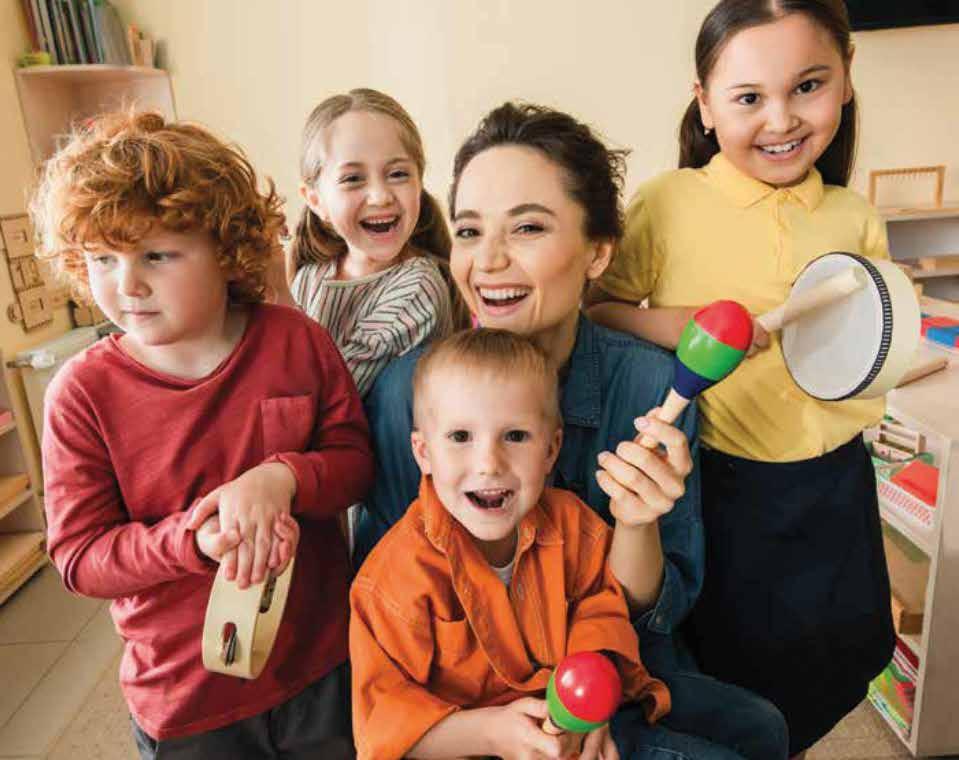

Social workers have long understood that family finding and the placement of black, Asian and Mixed Heritage children involves extra dimensions and challenges and the importance of faith communities to the network of support for children and families. Throughout 50 years of Coram Adoption, there has been constant development and adaptation to understand and meet the needs of children, to develop culturally sensitive practice and to nurture children’s identity and heritage.
Following the murder of George Floyd in 2020 and the subsequent Black Lives Matter movement there was a fresh impetus to re-examine how we support and meet the needs of black, asian and minority ethnic children. In considering the needs of these children it was thought that a group for parents of black, Asian, Minority Ethnic and Mixed Heritage families should be an essential addition to the range of support Coram offers adoptive parents.
As a result, a pilot group ran between October 2021 and March 2022 allowing families the opportunity to discuss a range of issues they had experienced at first hand including: incidents of racism and the lack of understanding of how this impacts on children of colour in school. The group also explored wider themes such as promoting identity, managing institutionalized racism and how to discuss these topics with children in an age-appropriate manner. Sessions also involved celebrations of diversity and sharing of poems, readings and songs. The success of the group is currently being formally evaluated, however initial feedback was very positive with families saying they valued the time to be thoughtful and reflective together.
“He was able to say things to the Coram therapist that he wasn’t able to say to us. We realised that it was really important for him to be able to talk to someone without worrying about upsetting them.”
“We adopted our youngest boy, through Coram. He was seven months old when he moved in with us and he’s 14 now. I was aware of the work that Coram was doing around life story and identity for adopted young people. The Tavistock Clinic at that time were offering support and I was really interested in that. We weren’t prescriptive about the ethnicity and background of a child we might adopt. We felt that whatever the heritage of that child, we’d do our best to support them. But we did know that Coram specialised in adoptions for children who were what was then known as “harder to place.” At the time that included Muslim heritage children. So, we thought there’s a great potential connection because we’re a Muslim family and we can offer that upbringing.
Our son’s cultural and ethnic heritage is from Kashmir and his birth mother had requested that he be adopted by a Muslim family. So we were a match in that respect.

One of the things that impressed me about Coram was that they said “We’re here to offer support at any point during your adopted child’s life.” Every child is different and you don’t know
how they are going to respond at different ages. For our family the need for extra support came when he was around 10 years old.
As it happened, the support we needed was around life story work. We’d done a lot of age appropriate life story work over the years but, as he got older, he became more preoccupied and upset by questions about his background and identity. It was affecting his mood and he was quite low sometimes. My husband and I both tried to respond in a way that we felt was helpful but eventually realised we needed some professional help. We got in touch with Coram and it was so helpful. What they offered was initially one-to-one sessions which then brought in me and my husband. The focus was very much about how the therapist could help us as parents have the conversations we needed to have to support our son. He was able to say things to the Coram therapist that he wasn’t able to say to us. We realised that it was really important for him to be able to talk to someone without worrying about upsetting them which he had been doing with my husband and I. For us, as parents, we learnt how to listen to him
without feeling we needed to rush in and try to make it better. Being an adoptive mum was absolutely formative for me in terms of my professional direction. I’d worked as a Civil Servant then taken time off when my children were growing up. When I began wondering what to do next I knew I wanted to use what I’d learned in terms of emotional development and the importance of support. Ultimately, that lead to me retraining as a child and adolescent psychotherapist. Faith identity has become a key interest of mine professionally and I’ve moved into the area of emotional support for children from Muslim heritage backgrounds. As a society we’re getting used to talking about ethnic cultural identity but not so much about faith identity. There’s a lot to be done, so I’ve ended up working in that field.”
Rachel is a Child and Adolescent Psychotherapist and Director of the Reflection Network, a charity focused on improving access to mental health support for Muslim-heritage children. reflectionnetwork.org
For the last 25 years, Coram has worked to advance practice in co-production with children and young people, delivering guided peer support groups, developing the first national young ambassadors programme, The Adoptables, researching views and creating national resources.
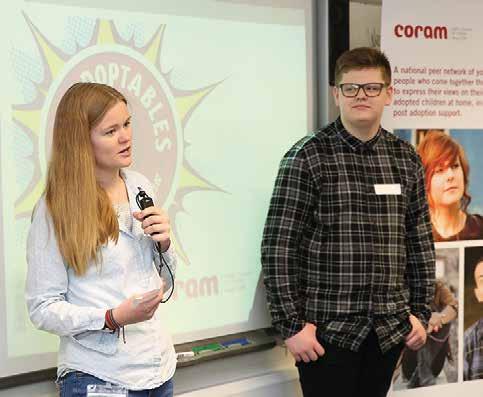
Coram East Midlands Coram East Midlands was formed by transfer from the Children’s Society in 2005 and was repeatedly recognised as Outstanding in multiple inspections.
The East Midland team has particular expertise and skills in the use of group work and individual work with adopted children. A key feature of its practice contribution was the establishment of support groups for children (under 7s, 7-13, 14+), enabling them to form friendships with other young
people who were adopted in the region, and to share fun activities and support each other in their development.
Families enjoyed the annual picnic whilst children looked forward to camping trips and their regular groups. Older young people were keen to help adopters to understand their feelings and experiences of contact, which they did initially through a film production and later in workshops and presenations to social workers and prospective adopters.
CoramBAAF has produced a number of books for adopted young people and theadults in their lives.

“I learned that family means different things to different people”
Key Stage 2 pupil who attended an Adoptables Schools Toolkit Workshop
Lorraine Wallis is a Research and Development Worker for Coram in the East Midlands. She established the local groups for adopted young people which eventually developed into the national Coram Adoptables programme.

“The idea of groups for adoptees began when we asked young people to fill in questionnaires about the things they found important. We’d ask the young people, ‘what do you want to focus on? What do you want people to understand?’ The three key things were: education, contact and more groups for adopted young people. The first group grew out of that and it belonged to the young people from the start. They named it, developed the ideas and made up the rules. Initially it was all about activities. In the very early days of mobile phones they spent a lot of time sitting in the same room texting each other discussing what they would do. So they called themselves “The Txtrs.” The Adoptables came later after one of the groups had the idea of referencing the Disney animation film, “The Incredibles.”
In 2000 Tony Blair was shaking up adoption and The
Children Act was going through consultation. There was a big interest in hearing what adopted young people thought. We were the only group at that point that I was aware of. One of the moments I’m most proud of is when three of our young people were asked to speak at a government consultation. There was a feedback session and they came to our little group and it was like wallpapering the walls because they’d written so much stuff! As the group became more well-known we got invited to conferences and to lead sessions for social workers and adopters. I like to think their input was influential in the later legislation that went through.
I remember one girl arrived at one of the camps and just paced around looking at the floor. She was very, very shy. We also had a rather quiet volunteer who was one of the staff on the trip and we encouraged the two of them
to pair up. On the last day there was an activity that involved hooking up to a safety wire and throwing yourself off the top of a telegraph pole. Literally taking a leap of faith. Lots of the boys were too scared to do it. This girl, who’d been bullied really badly, went from this protective worried child to throwing herself off this platform. When she got down, we both cried. Because what she’d achieved was so huge. Not only had she literally stayed the course and found a friend she felt safe with, she was the first one to jump off the platform. Ultimately, it was all about creating opportunities for the young people to feel good about themselves. To achieve in ways they may not have experienced before.”
Coram was the first voluntary adoption agency to have the privilege of delivering local authority adoption services in pioneering partnerships, which were the precursor of the development of regional adoption agencies, including our own Coram Ambitious for Adoption.
“Coram is now on the verge of replicating the Harrow partnership with two other local authorities. That will almost certainly benefit adoption work in the round and it will give a boost to concurrent planning”
Martin Narey, The Times, July 2011.
In 2006, the London Borough of Harrow was facing key challenges in the development and delivery if adoption services to meet the needs of its children and formed a ground breaking 10 year partnership with Coram to provide its service.

During the first three years, there was a cost-benefit to the authority of some £400,000 – a significant sum given the small scale of the service placing 10-12 children each year. The embedded work with the voluntary adoption agency, a pioneer in concurrent planning, led to 20% of adoptions being through early placement – the highest level known to that time.
The impact of the work and its distinctive approach led to further partnerships – with the London Borough of Redbridge, City of London and, later, Thurrock Council. What was then known as Coram Capital Adoption was recognised by government as the trail-blazer for regional adoption agency development.
The London Borough of Harrow is the lead local authority in the development and delivery of the new regional adoption agency, Coram Ambitious for Adoption which sees Coram deliver the services for nine local authorities in London, and for Slough Borough Council.
Under the leadership of Sue Lowndes, early permanence continues to feature strongly with early permanence placements accounting for 10% of placements in London in 2019-2022 and Coram VAA – under the leadership of Caroline Keane – recruits around 47% of adopters from diverse backgrounds, one of the highest in the country. Since 2014 Coram’s adoption team has worked in partnership with the charity Norwood, to welcome adopters from all cultural backgrounds, including Jewish families.
A new dedicated group for muslim adopters and support group for black, asian, mixed heritage and minority ethnic adopters are amongst the innovative approaches being taken. Coram Ambitious for Adoption also offers access to the Coram’s Creative Therapies under the Adoption Support Fund.
Paul Hewitt, Corporate Director of People Services for Harrow Council.
BROMLEY, CITY OF LONDON, HARROW, HILLINGDON, KENSINGTON AND CHELSEA, REDBRIDGE, SLOUGH, WALTHAM FOREST, WESTMINSTER
“Together we share a commitment to improving outcomes for children and are ambitious for adoption for those children who need it.”
It was to achieve such high levels of early placement to benefit their children that Cambridgeshire County Council entered another pioneering partnership with Coram for co-delivery of adoption services with in 2011.
The Coram manager, Barbro Loader, worked inside the local authority and managed its adoption service whilst we built a partnership approach to early permanence with the local judiciary, health and children’s social work colleagues. Under this scheme 25% of concurrent planning placements were made in the third year.
The independent evaluation of the benefit led to the formation of a new voluntary adoption agency Coram Cambridgeshire Adoption headed by Sarah Byatt, incorporating Coram’s Adopt Anglia voluntary adoption agency work and delivering the full adoption service for the county, including – for the first time ever – acting as the decision maker for children.
During the five years of the delivery, placement numbers were exceeded and more than 70% of children placed were in sibling groups, and the team won the award for Best Practice in the National Adoption Week Awards for their work in early permanence.
Coram-i was established to support insight and innovation across children’s services with the development of specific tools to inform outcomes and support decision making along with programme management services to support positive change. In addition to this, 30 agencies have utilised the adoption diagnostic framework to assess their strengths and opportunities to improve outcomes. Our Adoption Tracking Tool helps agencies make better use of the data already collected by providing real-time reports on performance and current operational status, giving staff and managers actionable data so that unnecessary delays can be minimised.
Since 2019, Coram has been providing the Secretariat to the Adoption and Special Guardianship Leadership Board (ASGLB), including running a voluntary, quarterly data collection on adoption from agencies in England. Through our analysis of the data and the support we provide to the ASGLB, we work to ensure the sector’s leaders have a clear understanding of the state of the adoption system and help develop solutions to address areas in need of improvement.
Creative connections in Kent Coram Kent Adoption learned from this approach with the Coram management services team, headed by Renuka Jeyarajah-Dent OBE and Yashi Shah MBE, supporting the improvement journey for the adoption service and increasing placements from 65 to 187, the largest number ever delivered by a single agency.
The partnership approach secured the Go Procurement Award of 2015 recognising the pioneering approach taken by the Authority.
This led to a creative partnership for the sustained and integrated delivery of adoption support with Coram providing clinical services – for adopted, fostered and SGO children – as an embedded part of a multi-disciplinary service. This was recognised for its success with the award for Best Practice in the National Adoption Week Awards in 2017.
More information: coram-i.org.uk
THE LARGEST NUMBER EVER DELIVERED BY A SINGLE AGENCY.
(Left) The Coram Cambridgeshire Adoption team winning the best practice award at the National Adoption Week Awards (Right) Renuka Jeyarajah-Dent and Kevin Yong receive the Go Procurement Award in 2015.


Coram continues to develop new approaches and partnerships to increase public understanding of adoption and encourage adopters to come forward for children waiting.
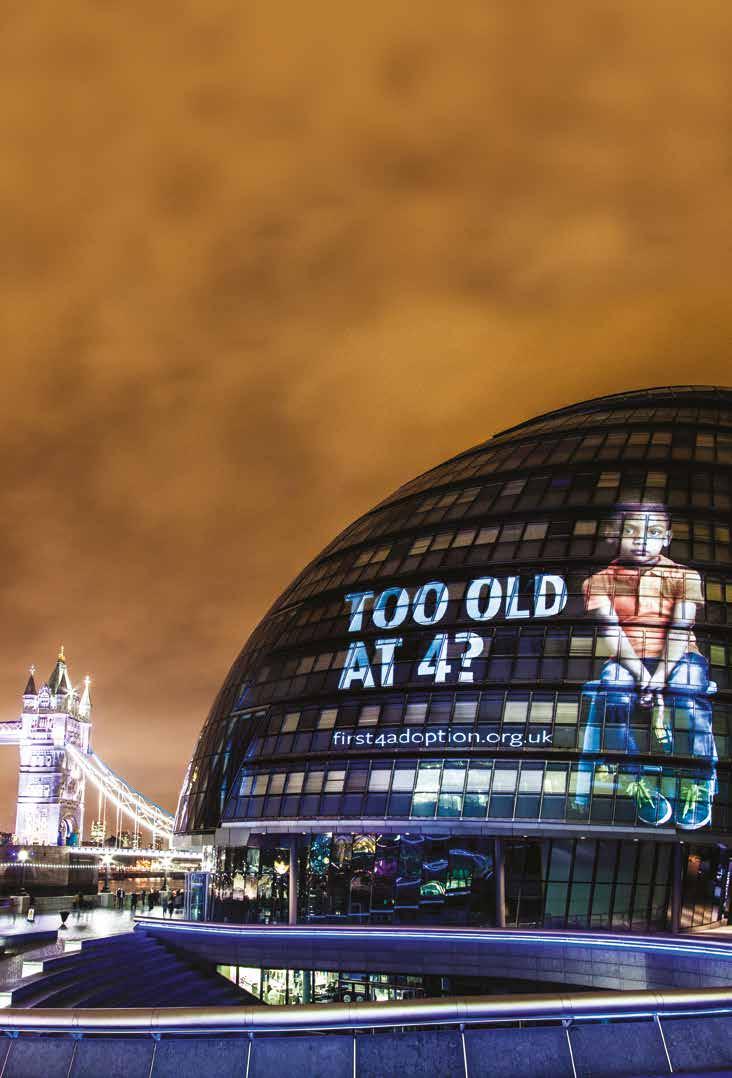
First4Adoption was launched in 2013 to provide guidance to potential adopters in England via a state-of-the art website and information line staffed by adoptive parents and social workers. Supported by the Department for Education and managed by Coram the service became a national hub for independent information and advice.
In the period 2013-17, the new national gateway for adoption supported more than a million people to consider adoption by providing a digital first approach to enquiries, developed and delivered by Coram on behalf of all agencies. Informed by the first research of its kind on the propensity for and barriers to adoption, First4Adoption aimed to build the confidence of adopters in coming forward to meet the needs of children waiting and enable them to find and enquire to an agency of their choice and then prepare themselves through e-learning for their adoption journey.

Adopter who called the First4Adoption
Between 2013-17 the free helpline, staffed by volunteer adopters for potential adopters, helped more than 17,000 people to explore issues they faced in their consideration of adoption. First4Adoption also offered bespoke customer service training and a mystery shopper service to help adoption agencies and local authorities in developing their skills in supporting those at the early stages of the adoption process.
The service won the Public Sector Digital Service of the year award in 2015 and the resources continue to be provided and maintained by Coram, last year enabling 221,000 users to take the next step of searching for an adoption agency.
First Steps, the first e-learning development in the field, remains a unique resource available free to all agencies and last year 2,098 adopters used it to reinforce their learning during assessment. The resources are now complemented by the Be My Family programme to enable national matching between children waiting and adopters who are yet to be matched (see page 47).
“It was everything I needed that moment and the adviser was just brilliant! Without their help I wouldn’t be an approved adopter today!”

‘’To become a family through adoption has simply been life-changing and life re-affirming. Our daughter Elle is the daughter we always wanted.”
Clare Grogan, actor and singer
The British Association of Adoption and Fostering (now CoramBAAF) created National Adoption Week in 1997 to support agencies across the country to come together to communicate the importance of adoption for children, recognise the work of professionals in supporting them, birth families and adoptive families, and celebrate the adopters who provide loving homes for children who need them.
Coram led the delivery of National Adoption Week Awards for three years between 2015 and 2017 achieving major partnerships which increased public awareness, helped agencies to welcome diverse adopters, and secured placements for children.
One of the most successful of these was Too Old at Four? the campaign to build awareness and opportunities for older children which featured a photograph specially taken by Mary McCartney, projected onto major landmark buildings across the country.

The contribution of adopters, social workers and individuals to the lives of children who needed adoption was recognised for three years in the National Adoption Awards.
Hosted by Coram at The Foundling Museum, the awards evenings enabled Ministers, policy makers and leaders to come together with children, families and professionals from across the country.
With categories including: Excellence in Adoption Practice, Adoption Social Worker of the Year, Adoption Support Practitioner, Adopter Champion, Adoption Blog and Lifetime Achievement, the awards recognised and celebrated the exceptional achievements of adoption professionals and adopters. Awards were decided by an independent panel of experts from a range of agencies and including adopters and adopted young people.
Distinguished presenters with a connection to adoption – such as Clare Grogan, David and Carrie Grant, Lesley Sharp and James O’Brien were joined by young people from the national young ambassadors programme, The Adoptables.
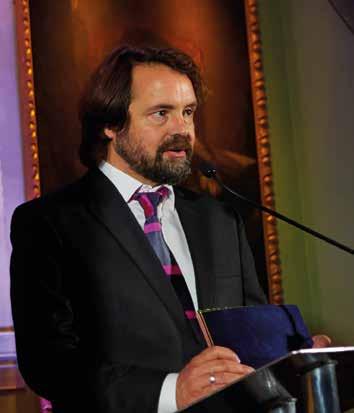
The three year partnership with the Mirror Group, led to 2 newspaper front pages and 2 double page spreads, featuring profiles of some of the individual children waiting the longest for adoptive families. In 2017 as a direct result of the campaign a young boy, Alfie was adopted by a family who saw his profile in the Daily Mirror.
Awards were decided by an independent panel of experts from a range of agencies and including adopters and adopted young people.

Since 2015 Coram has run more than 160 Adoption Activity Days (AADs), with over 6,000 children and 4,500 adopters. At least 1,400 children have been matched, more than any single adoption agency in the same period with Coram instrumental in 10% of all adoptions.
“AADs have added a new dimension to Coram’s work, they are bringing adopters and children together, giving prospective parents a chance to meet the children and vice versa to form a bond and begin an emotional connection that’s hopefully going to last a lifetime.”
Nadhim Zahawi, Minister for Intergovernmental Relations and Minister for Equalities
Adoption Activity Days (AADs) provide approved adopters, or prospective adopters at an advanced stage of approval, with the opportunity to interact with children who need adoptive parents, in a safe, supported and fun environment. Children are accompanied by their foster carers or social workers and are very carefully prepared with emphasis is on having fun.
Originally piloted in the UK in the 1970s by the British Association For Adoption and Fostering (now CoramBAAF), AADs became more widely available when the Department for Education included them as a key part of its adoption reform agenda in 2012. Since 2015, Coram has provided AADs as part of its national matching service, open to all and transcending organisational and geographical boundaries.
More information: coramadoption.org.uk/adoptionprocess/adoption/activity-days
The activity day model has now been extended to include long term fostering. The first Fostering Activity days began in 2018 and in the year to 2019 51% of children who attended an event found loving homes as a result.
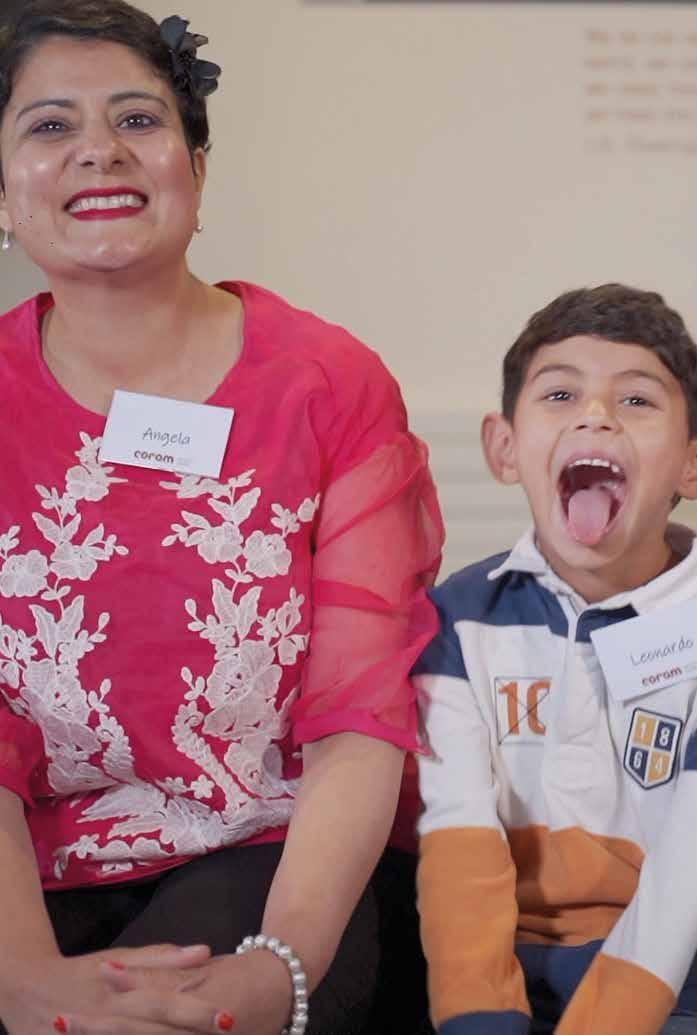
“We went to a fun day as Leonardo calls it in October 2019” says Angela. “We were lucky enough to meet Leonardo and the connection was immediate.”
“Leonardo is very good at football,” remembers Sulabh, “and he was practising his shots and I joined in. It really was an instant connection...” At that time Leonardo was almost 7 years old and at the end of the day, Angela and Sulabh expressed their interest and things happened very quickly. “It’s the second time I’ve fallen in love in my life,” says Angela. “First with Sulabh and now with Leonardo. As soon as I met him it was love at first sight. I didn’t expect it to be that way but that’s definitely how it happened. He chose us and we’ve been happy ever since.”
“Anyone thinking about adopting should attend an activity day – it will change the whole mindset for them.”
Adoptive Dad, Sulabh.
The work of Coram’s Adoption Activity Days team was the focus of “Finding Me a Family”, a two part series aired on Channel 4 in 2017. Cameras followed a group of children as they attended an Adoption Activity Day and viewers were able to watch children and adopters meet and interact for the first time and then to see what happened. The programme was widely featured in the press and on social media with particular attention to six-year-old Lewis who was matched with adoptive parents, Chris and Sharon, at the event.

The National Adoption Register was created in 2004 to ensure that all children from across the country had an entitlement – beyond their agency – to be considered for and find families from other agencies and locations.
Funded by the Department for Education, information held securely about children waiting to be adopted and approved adopters waiting to be matched was skilfully explored by the dedicated staff proactively to find and recommend links for them.
During the 14 years it operated, the Register provided a free national matching service to children, adopters and agencies. More than 3,200 children were matched and more than 5,000 adopters were able to access confidential advice from the team to inform their journey.
From 2015-19, Coram managed the statutory Adoption Register for England as part of its national matching service, now known as Be My Family.
In its final year of operation alone, 277 priority children were matched before the Register was suspended, making it impossible to continue.
Making a personal difference
Coram’s national matching services have been made possible thanks to the contribution of participating agencies and the generous support of grant making trusts and individuals who have made personal donations, run the marathon or undertaken other challenge activity.
Our thanks go particularly to the National Lottery, for its early support to Activity Days, and to Club Peloton, a charity that organises fundraising endurance cycling events of which Coram is a principal beneficiary.

The flagship Knight Frank Cycle from London to Cannes has seen more than 1000 riders – including a number of adopters – make their personal journey over 1500km to ensure children can have their best possible chance in life.
Coram continues to provide professional Exchange Days, which enable adopters to explore the profiles of children directly with children’s social workers, helping to overcome any barriers or preconceptions which might stand in the way.
Exchange days provide an important safety net for agencies, children and adopters seeking to ensure timely matches for children who wait. The days continued – with virtual as well as physical events – throughout the pandemic and to date 567 prospective adopter families have attended. Since 2019 a total of 3833 children have been profiled resulting in 21 children being matched with adoptive families.
Be My Family is now working with regional adoption and voluntary adoption agency colleagues to provide events in different parts of the country and targeted to additional needs.
More information: bemyfamily.org.uk

Originally known as The British Association for Adoption and Fostering (BAAF), CoramBAAF has been supporting practice and policy development in the family placement sector since 1980. The leading membership association CoramBAAF is open to organisations and individuals with a professional or personal interest in adoption, fostering, and kinship care.
1984 marked the launch of the Black Perspectives Advisory Committee –and throughout its existence, CoramBAAF has championed anti-racist and anti-oppressive practice initiatives. This work continues today with pioneering work around intersectionality and multiple identities.
In 2020, CoramBAAF marked its 40th birthday with a range of anniversary events and the publication of a special supplement of the highly-regarded peer-reviewed journal, Adoption & Fostering, featuring articles exploring significant themes over the past four decades.
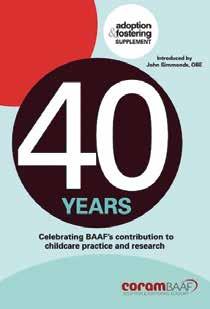
In 1997 saw the launch of the first ever National Adoption Week which continues to bring together people and organisations from across the country and from all walks of life to improve awareness of the challenges and opportunities around adoption.

John has been working in areas relating to social work and children for almost 50 years. As a social worker he acquired substantial experience in child protection, family placement and residential care settings before entering academia. At Goldsmiths College, University of London, he became Senior Lecturer in Social Work then Head of Social Work Programmes. In 2000, he joined the British Association for Adoption and Fostering (BAAF) as the Director of Policy, Research and Development. He is currently responsible for CoramBAAF’s contribution to the development of policy and practice in social work, health, the law and research.
John, who is himself an adopter, has written and edited numerous publications and is also Chair of the Kinship Care Alliance. His extensive work demonstrates his exceptional commitment to young people and to social care, and in 2015 he was awarded an OBE (Officer of the Order of the British Empire) for services to children and families.

CoramBAAF’s numerous achievements during those years have included successful campaigns to introduce new legislation such as national adoption standards, the creation of the Children’s Commissioner, early care planning, monitoring of permanency plans, the establishing of a national adoption register, mandatory assessment for adoption support, parental leave for adoptive parents and successful lobbying on behalf of unmarried and same-sex adopters.
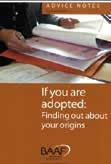
CoramBAAF continues to run the Adoption Search Reunion website which was launched in 2006 to inform adopted adults, birth relatives and adoption professionals about the changes being introduced by the Adoption and Children Act 2002. The website provides information for anyone researching an adoption that took place in the UK. CoramBAAF has also published a series of books for adopted children exploring issues around adoption.

More recently, throughout the pandemic, CoramBAAF produced practical, authoritative guidance to help practitioners and agencies navigate the complex issues they faced, including how to interpret the “flexibilities” introduced under the Adoption and Children (Coronavirus Amendment) Regulations 2020 and the use of technological solutions to carry out meetings with children, foster carers, adopters and social workers and continue the vital task of recruiting new families.
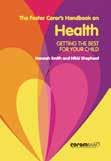
More
In 2022 CoramBAAF remains a key voice in our sector – its publications, forms and training are at the heart of family placement policy and practice with nearly all family placement organisations in England and Northern Ireland in membership and partnership arrangements with AFKA Scotland and AFA Cymru.
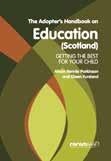
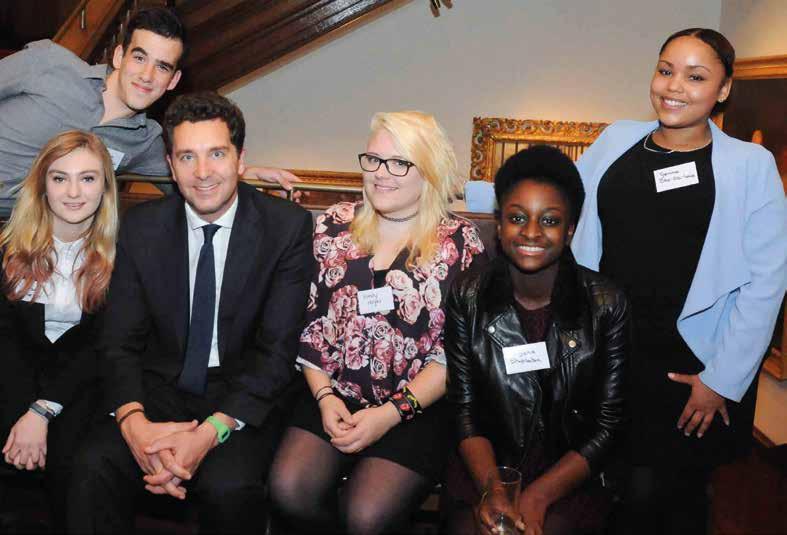
As the stories through the decades in this report show, adoption is a lifetime journey and also a success for the vast majority of young people, for whom it creates a permanent family, after the adverse experiences they faced as younger children.
Coram’s longitudinal research shows that – whilst there will be times of turbulence and challenge for many families including through adolescence – adopters overwhelmingly speak of the joy and love that adoption has brought to them. Through 50
years, there have been fewer than 1% of breakdowns in families supported by Coram Adoption.
Young people talk passionately of all that their adopters mean to them, even as they explore difficult feelings, memories or information about the reasons that adoption was considered the right option for their future.
Coram is proud of the lasting love that sustains them all on their journey and of the achievements of adopted children and young people in reaching their potential throughout their lives.
The young peoples groups coordinated by Lorraine Wallis (see p37) led to the formation of The Adoptables, the first and only national young ambassadors programme for young people who are adopted. Working with First4Adoption, the young people created Top Tips for people considering adoption, materials for preparation groups, and acted as judges in the National Adoption Week Awards.
Working with Coram Life Education – the largest provider of personal, social and health education for schools – young people created the Adoptables Toolkit, a teaching resource for
teachers to support other children to understand the issues of alternative care. Resources created by the Adoptables have been downloaded more than 1,675 times, and – along with the guide on Telling My Story – are available at coram.org.uk
Thanks go to The Queen’s Trust for their support which made the development of The Adoptables possible. Coram is now working with Microsoft to develop career entry workshops for adopted young people and is extending the reach of the work to young people in long term fostering and Special Guardianship.
Adult adoptee, Julia Whitehouse remembers her time as part of the Coram Adoptables. ‘’The Adoptables was a huge positive influence in my life. For the first time, I met people my age who just ‘got it’. They were my age, they were adopted, and we became great friends.

I was also given a platform to discuss my experiences, speak with decision makers, within schools, charities and the government. The group nurtured me and encouraged me to try new things, in particular public speaking. I also got the opportunity to perform my own writing on stage in London, make educational videos, speak with adopted parents, and zip wire over a wood!
Being involved in delivering the Schools Toolkit and helping create, educate and facilitate change in schools is so important. I was very nervous at first, as I don’t particularly enjoy public speaking. However, if I could help a child avoid the kind of experiences I had at school, then I was jolly well going to do it!
The Adoptables also led to me meeting my great friend Sarah who was also adopted and my age. We hit it off immediately. She just got the way I was feeling without me having to say anything. She understood my experiences innately because she had been through similar things. Having a friend like her is invaluable. I was part of the group for several years on and off and it really helped me. It nurtured my confidence and helped me turn my negative experiences into a tool that could help people. This made me feel empowered and gave me a purpose and motivation. Previously I’d kept my adoption a secret but the Adoptables helped me realise that it is not a taboo.
At times my adoption felt like it was the whole of me; it was my identity and was all encompassing. But it’s really only an experience which has shaped a part of me. I am forging the life that I would like; the Adoptables was part of this journey. I am now a junior producer in TV and am working
on a documentary series for Channel 4. I’ve just bought a flat and live there with my bunnies. I’m 29 now, have a great relationship with my parents (adopted parents, but they are my real parents, and the only parents I could ever want), have a girlfriend, friends and have fully embraced who I am. I’m finally happy in my own skin.”
From volunteering at activity days, offering advice and information, appearing in the media and featuring in research to serving as Coram trustees and governors, adopters and adopted young people give generously of their time to help others considering adoption.
Adopted people in the public eye play an important part in supporting public understanding of the role of adoption in modern society. Adoption is always for the few and not the many but when needed to secure a child’s future, provides the potential for them of a lifetime of difference.
James Naughtie is clear from his own family’s history on the importance of the ongoing work
of the Foundling Hospital and regularly returns to contribute to Coram’s Christmas Celebration.
Kate Adie served as a governor to Coram and has shared her own experiences of being adopted and later reunited with her birth family: “It’s been wonderful. Having had loving people who brought me up and then finding another set of people. That really is a double blessing.”
David and Carrie Grant adopted their son in 2012 and continue to

speak out for the needs of our most vulnerable children, also giving generously of their time and recognition to support the National Adoption Awards.
They played a key part, alongside other adopters and adopted young people, in the visit of Her Majesty The Queen in 2018, marking the 350th anniversary of the birth of Thomas Coram.
Anthony, now aged 21, grew up in London with his adoptive family. Anthony’s parents had two birth daughters aged 6 and 9 when they adopted him at 20 months and five years later went on to adopt another son.
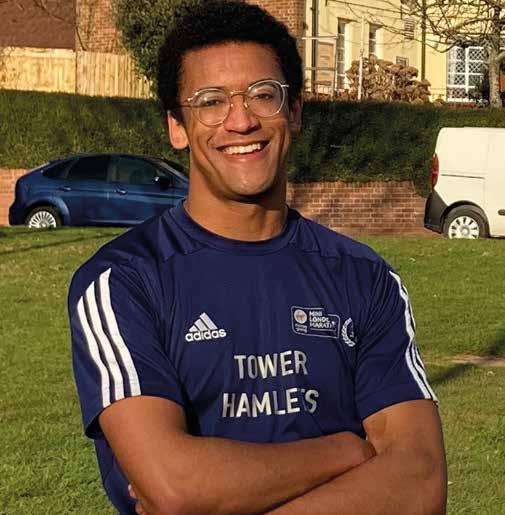
“In our family, there is no hierarchy between the birth kids and the adopted kids, we’re all one massive family. I remember feeling really loved and appreciated. I’m quite close to my brother, he still lives with my parents. I chat to both of my sisters quite a lot and I try to see them every time I get back from university.
My parents collated a Life Story Book with the help of Coram which has some letters from my birth mum and birth gran and pictures, explaining the adoption process and my foster mum. I just remember my earliest conversations with my parents about adoption always centred around that book. I never really had an issue around adoption. I think I had a really easy adoption process, my narrative has been so fixed and clear. It’s really important to make sure that adopted children are not ashamed because there is nothing to be ashamed of, it’s a really beautiful thing that my parents chose me.
My foster mum took care of me from when I was eight days old up to when I was adopted. She’s such an unsung hero, she’s been fostering for 35 years and she’s so quiet about it, she’s an absolute queen. I consider her my mum as well. It’s like I have three mums: birth, foster and adoptive.
Since being adopted, I’ve been so lucky to develop my music skills. My parents really supported me, taking me to concerts and practice sessions. I learned to play the trombone, clarinet and piano, as well as studying music theory up to grade eight.
When I was 11 I sang a solo of Amazing Grace at the Royal Albert Hall. It was such a weird feeling going out to perform in front of that many people, especially on my own, but it was really special. It was also the first time I met my birth randmother, and she was so proud of me. My adoptive grandmother came down from Scotland to watch it so there was a whole contingent supporting me.
My parents are amazing. They are just so selfless. Their goals are realised through helping other people, and I find that really inspiring. Their focus on charity and helping other people is something that I have very much internalised. I fundraised for Coram by running four miles, every four hours, for 48 hours. I wanted to give back to an organisation that gave me the life I—and all other children in care—should’ve had: a life with a loving family that enabled me to fulfil my potential.”
Anthony recently graduated from Exeter University and is about to start an MA in Philosophy of Psychiatry and Medicine at Kings College London.
“I wanted to give back to an organisation that gave me the life I – and all other children in care –should’ve had: a life with a loving family that enabled me to fulfil my potential.”
(Top-left) Diederick Santer adopted his little girl through Coram in 2014 and has since supported us by running three London marathons in aid of Coram.

(Left) Actor Claire Skinner at the National Adoption Week Awards.
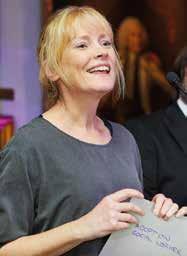
(Top-right) Actor Helena Bonham-Carter at Coram’s Chistmas Carol Service.

(Right) Actor and adoptee Lesley Sharp shares her Adoption story at the National Adoption Week Awards.
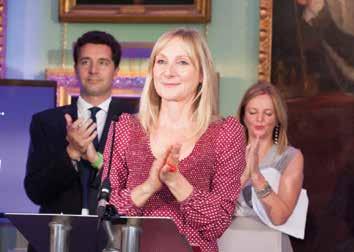
James Naughtie, former presenter of the BBC Radio 4 Today programme and his wife, Eleanor, the daughter of a former pupil of the Foundling Hospital. He is seen here supporting Coram at Christmas with singer Lulu and actor Joanna David.

James O’Brien, LBC presenter and author, was adopted 50 years ago and regularly features Coram and the issues of adoption on his programme. He is seen here with adopted children, and adopter Yotam Ottolenghi supporting the annual Christmas Celebration in 2021 at St Andrew’s Church where Thomas Coram and the original Foundling Hospital font and Handel’s organ are now housed.


“The best thing my wife and I ever did, along with having our two boys, was adopt our beautiful daughter. Nothing compares to the happiness and meaning she has given to our lives.”
David Lammy MP adopted his daughter through Coram.
It takes a village to bring up a child and it takes the concerted and diligent work of children’s social workers, directors of children’s services, their legal departments and the judiciary, agency decision makers, panels and adoption social workers, to support adopters in making A Lifetime of Difference. We thank them all for 50 years of service.
It takes policy makers, parliamentarians and government to keep a clear-sighted focus on the needs and timescales of the very most vulnerable children, for whom adoption is the plan.
The Adoption Reform programme stewarded by Tim Loughton and Edward Timpson as Children’s Ministers rewrote the platform of support for adopted families in the last decade.
As the first Secretary of State known to be adopted, Michael Gove spoke of his support to social workers in their vital work to support children and families in their journey.
Successive Secretaries of State have undertaken to sustain and support these needs in the National Adoption Strategy, working with dedicated national leadership forums.
(Top) The Rt Hon James Cleverly meeting with staff and adopters of Coram Ambitious for Adoption Regional Adoption Agency.
(Bottom) Edward Timpson, then Minister for Children and Families meeting with Paul Hewitt, an adoptee who chaired the founding Strategic Governance Board for Coram Ambitions for Adoption RAA until his retirement in 2022, and Andrew Carter, Director of Children’s Services for Lambeth and Chair of CoramBAAF.
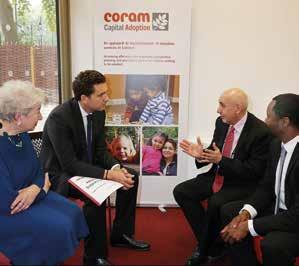
(Top) In 2022 The Rt Hon Nadhim Zahawi then Secretary of State for Education visited Coram – seen here with Krish Kandiah, Chair of the Adoption and Special Guardianship Leadership Board.

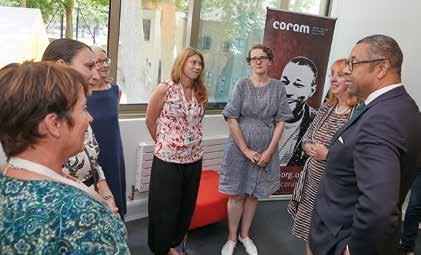
(Bottom) In 2020 the then Secretary of State Education Secretary, Gavin Williamson, was interviewed at Coram on the government’s ambitions for adoption.
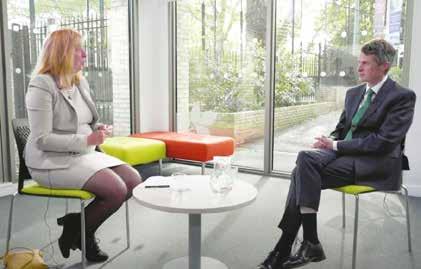
‘‘Coram supports some of the country’s most vulnerable children and is the leading exponent of concurrent planning. Coram has found that as a result of fostering by potential adopters, children are living with their adoptive families more quickly, and have fewer placements than would otherwise be the case.”
Prime Minister David Cameron’s announcement of plans to speed up the transition from fostering to adoption, July 2012.

2011
In a special report in The Times Martin Narey addressed issues around UK adoption and made a series of recommendations. He cited Coram’s “innovative work” in concurrent planning, called for “more adoptions of much younger children.”
2020
Coram’s CEO, Dr Carol Homden, met with the Education Secretary, Gavin Williamson, for a Q&A on the government’s adoption strategy.
David Cameron’s government launched its adoption reform programme. As part of the plans, the government funded Coram to become a National Centre of Excellence in Early Permanence.
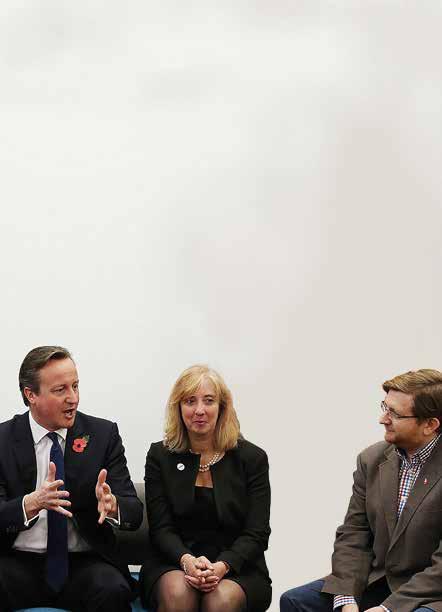
2015
Prime Minister David Cameron visited Coram and announced new measures to reduce the time children spend in care awaiting placement with an adoptive family.
Everywhere’’ cited Coram’s work three times.
2022
Dr Carol Homden and CoramBAAF Legal Adviser, Alexandra Conroy-Harris appeared before the House of Lords Select Committee on the Children and Families Act 2014.
In the coming decade, children are facing unprecedented challenges in securing the stable loving home that they need.
Children for whom adoption is the plan are now waiting longer than they should, despite the availability of adopters who have been assessed and approved as able to provide loving homes.
With both family courts and local authorities under pressure, there is delay at every stage of planning and some children may lose their chance of adoption if they age in care.
These delays could be mitigated by the much greater use of early permanence, providing transparency and support for birth parents and security in the face of uncertainty for children, and earlier use of all available approaches to matching.
As the children who were adopted at the peak of the adoption reform programme become teenagers, the need for support to them and their families are set to grow.
As we mark the important milestone of 50 years, Coram re-dedicates itself to championing better chances for children, now and forever.
As a voluntary adoption agency, Coram Adoption will prepare a diverse group of adopters from all backgrounds able and willing to consider children in the care system.
Coram Ambitious for Adoption will work with our regional adoption agency partners to secure the families they need for all the children in their timescales.
We shall continue to innovate in practice, in multi-cultural perspectives, work with schools, co-production with adopted young people, delivering creative therapy, nurturing identity and relationships and addressing contact issues in the digital era.
CoramBAAF will enable and support the community of social work practice across the UK with specialist advice, practice training and publications.
Coram’s national early permanence and matching services will support the RAA leaders and VAA colleagues in delivering the right placement at the right time
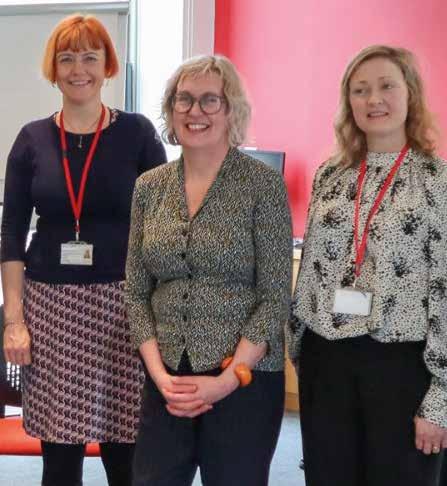
We shall inform and inspire policy development with practice evidence and longitudinal research.
We shall call for further investment in consistent support for birth families, for expansion of early permanence placement, parity for self-employed adopters and the long term support that every child from the care system deserves.
Baby Mia and her adoptive parents were amongst those who met Her Majesty Queen Elizabeth II when she opened the building on the Coram Campus named for her. Made possible by the generous support of The Queen’s Trust, it stands as a tribute to our ongoing commitment to children’s rights and welfare.
